2.9. Txomin Bornaetxea: Modeling debris flow source areas
2.9.1. 1.0 Objectives of the project
Debris flows are a particular type of landslides that are able to transport a large amount of sediments down the slope. Commonly they present three different functional zones: source, transportation and deposition.
The objective of this project is to generate numerical models that predict the probability of a given pixel to be a debris flow souce zone. The study area for this case is placed in the Rocky Mountains of British Columbia, Canada, were medium to high mountains landscpe shows a historical landslide prone conditions.
The basic input data are:
A polygon shapefile containing a large amount of landslides of different type, including debris flow separated by the functional zones.
A set of digital elevation layers in tif format provided by different sources.
[1]:
from IPython.display import Image
Image("/home/txomin/LVM_shared/Project/Figures/Fig_1_Location_map.png" , width = 500, height = 300)
[1]:
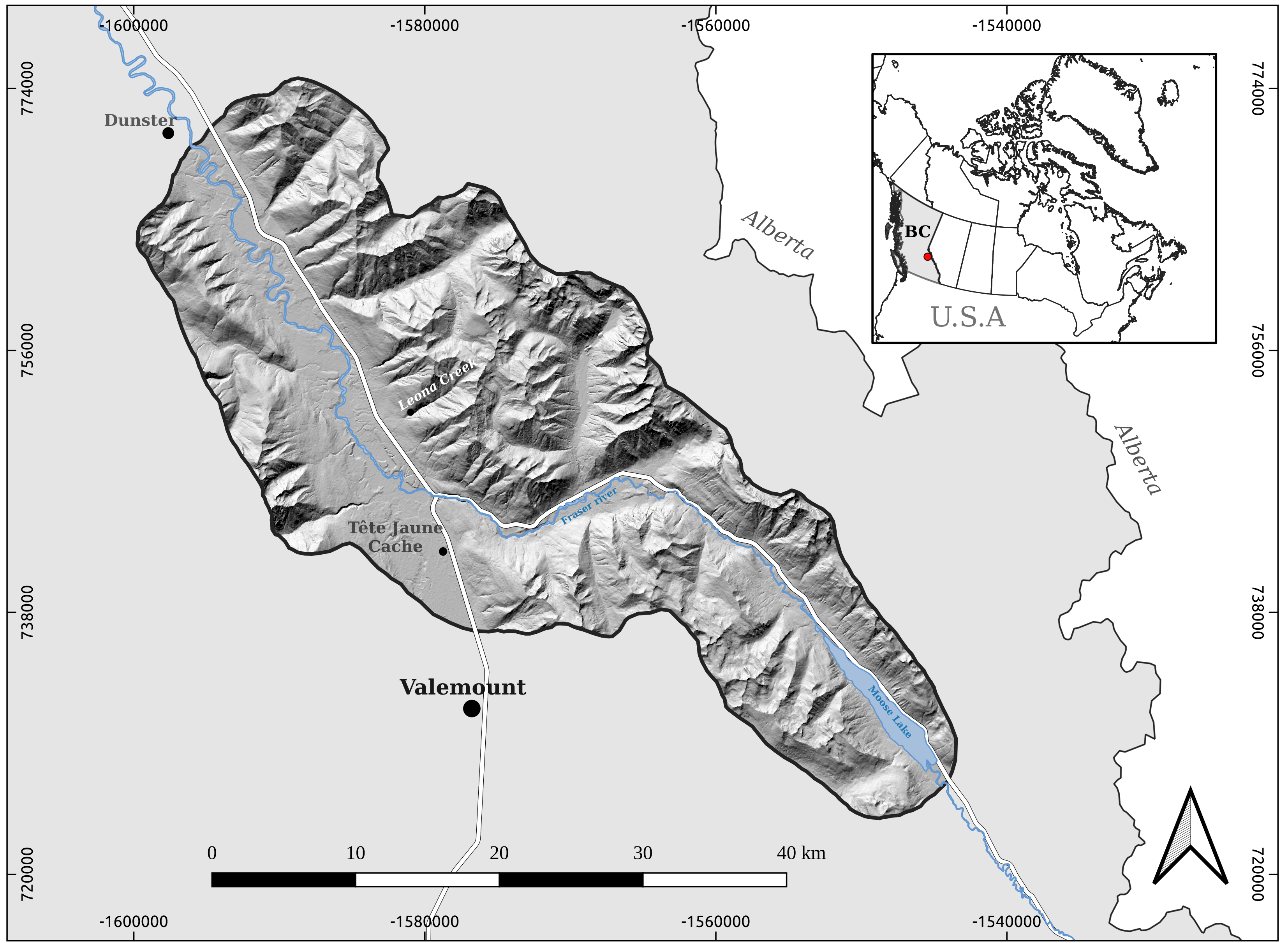
2.9.2. 2.0 Data Pre-Processing
2.9.2.1. 2.1- DEM EXPLORATION AND COMPOSITION
The eastern part of the study area is covered by a DEM data set generated with LiDAR data and provided in smaller tiles with resolution 1x1 meterr. These files are in ESRI binary format .adf. Therefore we carried out a merging and resampling processes in order to obtain one single DEM:
[ ]:
%%bash
mkdir TIF_files
for i in $(ls -1 | grep -v TIF_files); do
input=$(echo $i/w001001.adf)
output=$(echo TIF_files/${i}.tif)
gdal_translate -a_srs EPSG:2955 -of GTiff $input $output;
done
gdal_merge.py -ot Float32 -of GTiff -o mooselake_merged_1x1.tif TIF_files/*.tif
gdal_translate mooselake_merged_1x1.tif mooselake_merged_5x5.tif -tr 5 5
On the other hand, for the western part of the study area only the native LiDAR .laz files were provided. In order to generate a 5x5 .tif file we carried out the following work flow using pdal and gdal libraries:
The complete process spent ~ 10 hours on the server [1635 .laz files]
[ ]:
%%bash
# Band 1 = min; Band 2 = max; Band 3 = mean; Band 4 = idw; Band 5= count; Band 6 = stdev
band_num=1
file_list=''
# Loop to extract only class 2 points (ground points) from LAZ files
for i in *.laz
do
echo $i
name=$(echo $i | cut -f1 -d'.')
name=$name"_class2.laz"
pdal translate $i $name --json class_2_filter.json
# Append the name of each file like file1 file2 file3 ...
file_list=`echo "$file_list $name"`
echo $file_list
done
# merge all the LAZ files that contain only class 2 points into one single file
pdal merge $file_list merged_file.laz
#to define the coordinate system
pdal pipeline proj_deff.json
# generate the multiband raster file with the measured values within each pixel with 2.5x2.5
pdal pipeline to_raster.json
# resample the final dtm to 5x5 resolution
gdal_translate dtm_2_5_.tif dtm_5_.tif -tr 5 5
# fill the void pixels by IDW interpolation
gdal_fillnodata.py -md 20 -of GTiff dtm_5_.tif dtm_5_idw.tif
Once we have the two DEM files dtm_5_idw.tif [western part] and mooselake_merged_5x5.tif [eastern part], we are going to verify that their NaData value and data Type are identical:
[2]:
%%bash
cd /home/txomin/LVM_shared/Project/Valemount_data/dtm/
for i in $(echo "dtm_5_idw.tif mooselake_merged_5x5.tif"); do echo $i; gdalinfo $i | grep NoData; done
echo ""
for i in $(echo "dtm_5_idw.tif mooselake_merged_5x5.tif"); do echo $i; gdalinfo $i | grep Type; done
echo ""
for i in $(echo "dtm_5_idw.tif mooselake_merged_5x5.tif"); do echo $i; gdalinfo $i | grep Pixel; done
dtm_5_idw.tif
NoData Value=-9999
mooselake_merged_5x5.tif
NoData Value=-9999
dtm_5_idw.tif
Band 1 Block=14618x1 Type=Float64, ColorInterp=Gray
mooselake_merged_5x5.tif
Band 1 Block=5804x1 Type=Float64, ColorInterp=Gray
dtm_5_idw.tif
Pixel Size = (5.000000000000000,-5.000000000000000)
mooselake_merged_5x5.tif
Pixel Size = (5.000000000000000,-5.000000000000000)
Since everything seem to be correct, we combined the two layer in one single DEM using pk_composite and considering the average value when there are overlapping pixels.
Actually a more complex cleaning procedure was needed but for the sake of the example lets pretend this ideal situation :-)
Indeed, I had to use also gdal_edit.py, pkreclass, gdal_calc.py …
[ ]:
%%bash
cd /home/txomin/LVM_shared/Project/Valemount_data/dtm/
pkcomposite -i mooselake_merged_5x5.tif -i dtm_5_idw.tif -o /home/txomin/LVM_shared/Project/Valemount_data/Raster_variables/elevation2.tif -srcnodata -9999 -dstnodata -9999 -cr meanband
cd /home/txomin/LVM_shared/Project/Valemount_data/Raster_variables/
gdal_edit.py -a_nodata -9999 elevation2.tif
gdalinfo -mm elevation2.tif
[3]:
import rasterio
from rasterio import *
from rasterio.plot import show
from rasterio.plot import show_hist
raster = rasterio.open("/home/txomin/LVM_shared/Project/Valemount_data/Raster_variables/elevation2.tif")
rasterio.plot.show(raster)
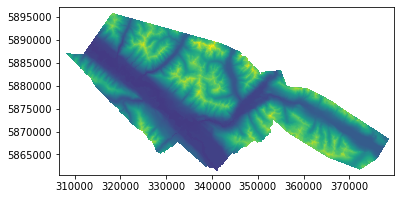
[3]:
<matplotlib.axes._subplots.AxesSubplot at 0x7ff9d7374cd0>
2.9.2.2. 2.2- LANDSLIDE INVENTORY EXPLORATION AND EXTRACTION OF SOURCE ZONES
Now we are going to explore the information contained in the landslide inventoy shapefile.
[4]:
%%bash
cd /home/txomin/LVM_shared/Project/Valemount_data/
ogrinfo -so Valemount_landslide_inventory_2022.shp Valemount_landslide_inventory_2022 | grep Count
ogrinfo -so Valemount_landslide_inventory_2022.shp Valemount_landslide_inventory_2022 | tail -10
Feature Count: 2191
Data axis to CRS axis mapping: 1,2
id: Integer64 (10.0)
Lnds_name: String (80.0)
Lnds_zone: String (80.0)
Type: String (80.0)
Ortho_1x1: String (10.0)
Google: String (10.0)
LiDAR: String (10.0)
Confidence: Integer64 (10.0)
Channelize: String (10.0)
Next step is to extract only the polygons classified as “debris flow” and save just those classified as “source” zones.
[5]:
%%bash
cd /home/txomin/LVM_shared/Project/Valemount_data/
ogr2ogr -sql "SELECT * FROM Valemount_landslide_inventory_2022 WHERE Type='debris flow' AND Lnds_zone='source'" debris_flow_sources_2.shp Valemount_landslide_inventory_2022.shp
ogrinfo -so debris_flow_sources_2.shp debris_flow_sources_2 | grep Count
ogrinfo -so debris_flow_sources_2.shp debris_flow_sources_2 | tail -10
Feature Count: 463
Data axis to CRS axis mapping: 1,2
id: Integer64 (10.0)
Lnds_name: String (80.0)
Lnds_zone: String (80.0)
Type: String (80.0)
Ortho_1x1: String (10.0)
Google: String (10.0)
LiDAR: String (10.0)
Confidence: Integer64 (10.0)
Channelize: String (10.0)
[6]:
import geopandas
from matplotlib import pyplot
inventory = geopandas.read_file("/home/txomin/LVM_shared/Project/Valemount_data/Valemount_landslide_inventory_2022.shp")
inventory_sources = geopandas.read_file("/home/txomin/LVM_shared/Project/Valemount_data/debris_flow_sources_2.shp")
fig, (ax1,ax2) = pyplot.subplots(nrows=1, ncols=2, figsize=(20, 16))
ax1 = inventory.plot(ax=ax1)
ax1.set_title("Complete Inventory")
ax2 = inventory_sources.plot(ax=ax2)
ax2.set_title("Source Inventory")
[6]:
Text(0.5, 1, 'Source Inventory')

2.9.2.3. 2.3- GENERARION OF THE SPATIAL VARIABLES
At this point we need a set of raster maps from which we are going to extract the different variables for the data set generation. * It is very important that all the raster maps have the same size and are correctly aligned so all the pixels overlap perfectly. * The dependent variable (source inventory) has to be in perfect alignement as well.
We are going to use the pyjeo library to prepare the final inventory raster layer where: * The value of 0 is given to all the pixels in the DEM that do NOT contain a debris flow source area. * The value of 1 is given to all the pixels in the DEM that do NOT contain a debris flow source area. * NoData value (-9999) are given to the valley bottom plain areas. Those where manually defined by a polygon shapefile.
[ ]:
import pyjeo as pj
from matplotlib import pyplot as plt
import numpy as np
sources ='/home/txomin/LVM_shared/Project/Valemount_data/debris_flow_sources_2.shp'
plains = '/home/txomin/LVM_shared/Project/Valemount_data/flood_planes.shp'
elevation = '/home/txomin/LVM_shared/Project/Valemount_data/Raster_variables/elevation.tif'
[ ]:
s = pj.JimVect(sources)
p = pj.JimVect(plains)
jim =pj.Jim(elevation)
[ ]:
jim[jim>0] = 0
jim[s] = 1
jim[p] = -9999
np.unique(jim.np())
[ ]:
%matplotlib inline
jim1 = pj.Jim(jim)
jim1[jim1<0] = 2
fig = plt.figure()
ax1 = fig.add_subplot(111)
ax1.imshow(jim1.np())
plt.show()
[ ]:
jim.properties.setNoDataVals(-9999)
jim.io.write('/home/txomin/LVM_shared/Project/Valemount_data/Raster_variables/inventory_clean_rast.tif')
[ ]:
jim_mask =pj.Jim(elevation)
jim_mask[jim_mask>0] = 1
jim_mask.properties.setNoDataVals(-9999)
jim.io.write('/home/txomin/LVM_shared/Project/Valemount_data/Raster_variables/mask_1.tif')
A final step is needed in order to remove some source area pixels out of the boundaries of the DEM.
[ ]:
%%bash
gdal_calc.py -A /home/txomin/LVM_shared/Project/Valemount_data/Raster_variables/mask_1.tif \
-B /home/txomin/LVM_shared/Project/Valemount_data/Raster_variables/inventory_clean_rast.tif \
--calc="A*B" --outfile /home/txomin/LVM_shared/Project/Valemount_data/Raster_variables/inventory_def.tif --NoDataValue=-9999
[ ]:
inventory = '/home/txomin/LVM_shared/Project/Valemount_data/Raster_variables/inventory_def.tif'
jim =pj.Jim(inventory)
[ ]:
%matplotlib inline
jim1 = pj.Jim(jim)
jim1[jim1<0] = 2
fig = plt.figure()
ax1 = fig.add_subplot(111)
ax1.imshow(jim1.np())
plt.show()
In the following lines we are going to generate the geomorphometric variables: slope and aspect + An additional variable that was generated in Grass, flow_accumulation “r.watershed -a -s elevation=elevation accumulation=flow_acc threshold=20”
[ ]:
%%bash
cd /home/txomin/LVM_shared/Project/Valemount_data/Raster_variables/
# calculate slope
gdaldem slope -co COMPRESS=DEFLATE -co ZLEVEL=9 elevation.tif slope.tif
# calculate apect
gdaldem aspect -co COMPRESS=DEFLATE -co ZLEVEL=9 elevation.tif aspect.tif
[7]:
! cd /home/txomin/LVM_shared/Project/Valemount_data/Raster_variables/
import rasterio
from rasterio import *
from rasterio.plot import show
from matplotlib import pyplot
inventory = rasterio.open("/home/txomin/LVM_shared/Project/Valemount_data/Raster_variables/inventory_def.tif")
rasterio.plot.show(inventory, title='INVENTORY', cmap="binary")
fig, ((ax1, ax2),(ax3, ax4))= pyplot.subplots(2,2, figsize=(21,7))
map1 = rasterio.open("/home/txomin/LVM_shared/Project/Valemount_data/Raster_variables/elevation.tif")
show((map1, 1), ax=ax1, title='elevation', cmap="CMRmap")
map2 = rasterio.open("/home/txomin/LVM_shared/Project/Valemount_data/Raster_variables/slope.tif")
show((map2, 1), ax=ax2, title='slope', cmap="Reds")
map3 = rasterio.open("/home/txomin/LVM_shared/Project/Valemount_data/Raster_variables/aspect.tif")
show((map3, 1), ax=ax3, title='aspect', cmap="prism")
map4 = rasterio.open("/home/txomin/LVM_shared/Project/Valemount_data/Raster_variables/flow_acc.tif")
show((map4, 1), ax=ax4, title='flow_accumulation', cmap="prism")
pyplot.show()
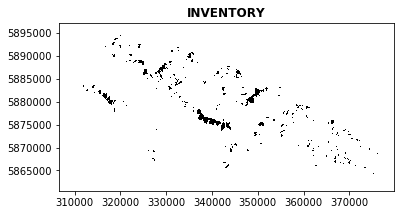
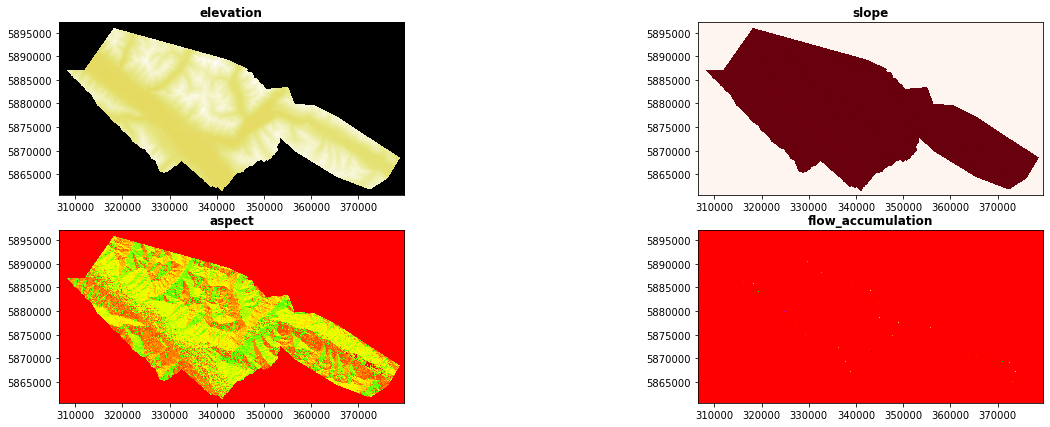
2.9.2.4. 2.4- EXTRACT THE DATA TABLE FROM RASTER LAYERS
The objective of this section is to organize the data in a tabular format in a way that: * Each row corresponds to one single pixel observation * Each column corresponds to the value that contains each raster map in the same pixel, i.e, the variables.
[ ]:
%%bash
cd /home/txomin/LVM_shared/Project/Valemount_data/Raster_variables/
# generate a virtual multiband layer with all the raster maps
gdalbuildvrt -separate variables_stack_2.vrt inventory_def.tif elevation.tif slope.tif aspect.tif flow_acc.tif
gdalinfo variables_stack_2.vrt | tail -23
echo ""
echo ""
# generate the xyz table skipinig nodata pixels
gdal2xyz.py -allbands -skipnodata variables_stack_2.vrt /home/txomin/LVM_shared/Project/Valemount_data/valemount_source_dataset_2.txt
#head -20 /home/txomin/LVM_shared/Project/Valemount_data/valemount_source_dataset_2.txt
[9]:
%%bash
head -20 /home/txomin/LVM_shared/Project/Valemount_data/valemount_source_dataset_2.txt
318111.460 5895928.235 0 2149.23 -9999 -9999 6
318116.460 5895928.235 0 2151.8 -9999 -9999 6
318121.460 5895928.235 0 2153.36 -9999 -9999 1
318126.460 5895928.235 0 2154.47 -9999 -9999 1
318106.460 5895923.235 0 2148 -9999 -9999 742
318111.460 5895923.235 0 2151.51 -9999 -9999 9
318116.460 5895923.235 0 2154.06 33.5292 318.359 5
318121.460 5895923.235 0 2155.99 31.6916 328.32 5
318126.460 5895923.235 0 2157.46 -9999 -9999 1
318131.460 5895923.235 0 2158.57 -9999 -9999 10
318136.460 5895923.235 0 2159.91 -9999 -9999 6
318141.460 5895923.235 0 2161.81 -9999 -9999 6
318146.460 5895923.235 0 2163.8 -9999 -9999 1
318151.460 5895923.235 0 2165.67 -9999 -9999 1
318106.460 5895918.235 0 2150.79 -9999 -9999 43
318111.460 5895918.235 0 2154.07 37.8872 310.268 741
318116.460 5895918.235 0 2156.66 34.1429 317.984 8
318121.460 5895918.235 0 2158.6 31.4858 325.843 4
318126.460 5895918.235 0 2160.15 30.3317 331.319 4
318131.460 5895918.235 0 2161.48 30.7167 333.778 4
2.9.3. 3.0 Data Exploration
Once we have our information well organized in a table, let’s explore and refine it.
[1]:
from IPython.display import Image
import rasterio
from rasterio import *
from rasterio.plot import show
from rasterio.plot import show_hist
from sklearn.preprocessing import MinMaxScaler
import geopandas
import pandas as pd
from matplotlib import pyplot
#import skgstat as skg # It gives AttributeError: module 'plotly.graph_objs' has no attribute 'FigureWidget'
import numpy as np
import seaborn as sns
[3]:
original_data_table = pd.read_csv("/home/txomin/LVM_shared/Project/Valemount_data/valemount_source_dataset_2.txt", sep=" ", index_col=False)
original_data_table.columns = ["X", "Y", "source", "elevation", "slope", "aspect", "flow_acc"]
pd.set_option('display.max_columns',None)
original_data_table.head(10)
[3]:
| X | Y | source | elevation | slope | aspect | flow_acc | |
|---|---|---|---|---|---|---|---|
| 0 | 318116.46 | 5895928.235 | 0 | 2151.80 | -9999.0000 | -9999.000 | 6.0 |
| 1 | 318121.46 | 5895928.235 | 0 | 2153.36 | -9999.0000 | -9999.000 | 1.0 |
| 2 | 318126.46 | 5895928.235 | 0 | 2154.47 | -9999.0000 | -9999.000 | 1.0 |
| 3 | 318106.46 | 5895923.235 | 0 | 2148.00 | -9999.0000 | -9999.000 | 742.0 |
| 4 | 318111.46 | 5895923.235 | 0 | 2151.51 | -9999.0000 | -9999.000 | 9.0 |
| 5 | 318116.46 | 5895923.235 | 0 | 2154.06 | 33.5292 | 318.359 | 5.0 |
| 6 | 318121.46 | 5895923.235 | 0 | 2155.99 | 31.6916 | 328.320 | 5.0 |
| 7 | 318126.46 | 5895923.235 | 0 | 2157.46 | -9999.0000 | -9999.000 | 1.0 |
| 8 | 318131.46 | 5895923.235 | 0 | 2158.57 | -9999.0000 | -9999.000 | 10.0 |
| 9 | 318136.46 | 5895923.235 | 0 | 2159.91 | -9999.0000 | -9999.000 | 6.0 |
All the rows with NoData values (-9999) are going to be excluded from the dataset.
[4]:
print("original_data_table ", original_data_table.shape)
clean_data_table = original_data_table.loc[(original_data_table["aspect"]!=-9999) & (original_data_table["source"]!=-9999)]
print("clean_data_table ", clean_data_table.shape)
clean_data_table.head(10)
original_data_table (46517746, 7)
clean_data_table (39357034, 7)
[4]:
| X | Y | source | elevation | slope | aspect | flow_acc | |
|---|---|---|---|---|---|---|---|
| 5 | 318116.46 | 5895923.235 | 0 | 2154.06 | 33.5292 | 318.359 | 5.0 |
| 6 | 318121.46 | 5895923.235 | 0 | 2155.99 | 31.6916 | 328.320 | 5.0 |
| 14 | 318111.46 | 5895918.235 | 0 | 2154.07 | 37.8872 | 310.268 | 741.0 |
| 15 | 318116.46 | 5895918.235 | 0 | 2156.66 | 34.1429 | 317.984 | 8.0 |
| 16 | 318121.46 | 5895918.235 | 0 | 2158.60 | 31.4858 | 325.843 | 4.0 |
| 17 | 318126.46 | 5895918.235 | 0 | 2160.15 | 30.3317 | 331.319 | 4.0 |
| 18 | 318131.46 | 5895918.235 | 0 | 2161.48 | 30.7167 | 333.778 | 4.0 |
| 19 | 318136.46 | 5895918.235 | 0 | 2162.71 | 31.3158 | 331.904 | 5.0 |
| 20 | 318141.46 | 5895918.235 | 0 | 2164.15 | 30.2020 | 328.198 | 5.0 |
| 21 | 318146.46 | 5895918.235 | 0 | 2165.63 | 27.7112 | 323.888 | 5.0 |
We verify that there are no extrange values
[13]:
clean_data_table.loc[:, ~clean_data_table.columns.isin(['X', 'Y'])].describe()
[13]:
| source | elevation | slope | aspect | flow_acc | |
|---|---|---|---|---|---|
| count | 3.935703e+07 | 3.935703e+07 | 3.935703e+07 | 3.935703e+07 | 3.935703e+07 |
| mean | 4.226281e-02 | 1.588436e+03 | 2.620067e+01 | 1.750631e+02 | 2.457294e+03 |
| std | 2.011881e-01 | 4.517979e+02 | 1.206892e+01 | 1.037492e+02 | 1.529432e+05 |
| min | 0.000000e+00 | 7.330930e+02 | 4.945590e-04 | 0.000000e+00 | 1.000000e+00 |
| 25% | 0.000000e+00 | 1.188990e+03 | 1.773670e+01 | 7.559980e+01 | 3.000000e+00 |
| 50% | 0.000000e+00 | 1.604960e+03 | 2.682900e+01 | 1.868490e+02 | 1.000000e+01 |
| 75% | 0.000000e+00 | 1.966760e+03 | 3.413430e+01 | 2.566960e+02 | 3.000000e+01 |
| max | 1.000000e+00 | 2.845970e+03 | 8.715910e+01 | 3.599990e+02 | 2.062980e+07 |
Count observations with source = 1 vs source = 0
[14]:
print("Source area observations: ", (clean_data_table["source"] == 1).sum())
print("Non-Source area observations: ", (clean_data_table["source"] == 0).sum())
Source area observations: 1663339
Non-Source area observations: 37693695
[15]:
clean_data_table.loc[:, ~clean_data_table.columns.isin(['X', 'Y', 'source'])].hist(figsize=(12, 8))
#clean_data_table.loc[:, ~clean_data_table.columns.isin(['X', 'Y', 'source'])].boxplot(figsize=(12, 8))
[15]:
array([[<matplotlib.axes._subplots.AxesSubplot object at 0x7ff9cdc42ca0>,
<matplotlib.axes._subplots.AxesSubplot object at 0x7ff9cdc68550>],
[<matplotlib.axes._subplots.AxesSubplot object at 0x7ff9cdc10dc0>,
<matplotlib.axes._subplots.AxesSubplot object at 0x7ff9cdbc8640>]],
dtype=object)
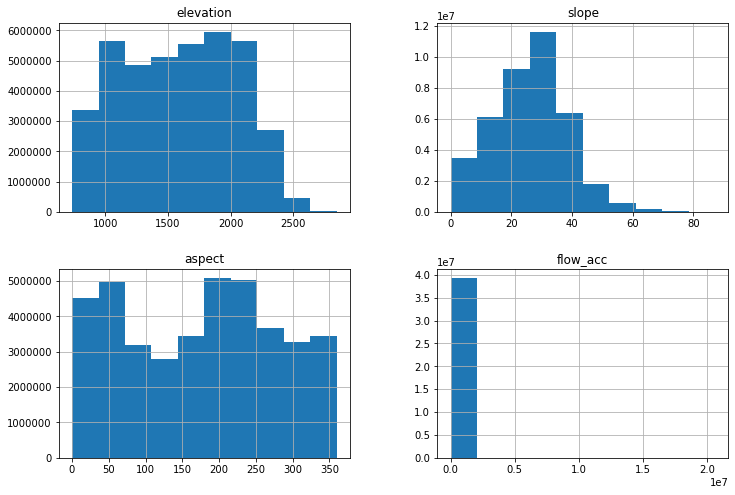
[16]:
print("flow_acc > 20000000: ", (clean_data_table["flow_acc"] > 20000000).sum())
print("flow_acc > 10000000: ", (clean_data_table["flow_acc"] > 10000000).sum())
print("flow_acc > 5000000: ", (clean_data_table["flow_acc"] > 5000000).sum())
print("flow_acc > 2500000: ", (clean_data_table["flow_acc"] > 2500000).sum())
print("flow_acc > 1000000: ", (clean_data_table["flow_acc"] > 1000000).sum())
flow_acc > 20000000: 550
flow_acc > 10000000: 1677
flow_acc > 5000000: 5497
flow_acc > 2500000: 7933
flow_acc > 1000000: 11605
In the following code blocks we are going to normaliza the values of the explanatory variables
[5]:
features = clean_data_table.loc[:, ~clean_data_table.columns.isin(['X', 'Y', 'source'])]
cols = clean_data_table.iloc[:,[3,4,5,6]].columns.values
print(cols)
features
['elevation' 'slope' 'aspect' 'flow_acc']
[5]:
| elevation | slope | aspect | flow_acc | |
|---|---|---|---|---|
| 5 | 2154.06 | 33.52920 | 318.3590 | 5.0 |
| 6 | 2155.99 | 31.69160 | 328.3200 | 5.0 |
| 14 | 2154.07 | 37.88720 | 310.2680 | 741.0 |
| 15 | 2156.66 | 34.14290 | 317.9840 | 8.0 |
| 16 | 2158.60 | 31.48580 | 325.8430 | 4.0 |
| ... | ... | ... | ... | ... |
| 46512529 | 2040.47 | 8.61856 | 354.3010 | 1.0 |
| 46512530 | 2039.94 | 14.53420 | 31.1026 | 1.0 |
| 46512531 | 2039.16 | 18.42540 | 38.7273 | 1.0 |
| 46512532 | 2037.82 | 23.45520 | 52.2631 | 1.0 |
| 46512533 | 2035.73 | 25.49600 | 52.1357 | 1.0 |
39357034 rows × 4 columns
[6]:
scaler = MinMaxScaler()
scaled_features = scaler.fit_transform(features)
type(scaled_features)
[6]:
numpy.ndarray
[19]:
scaled_features.shape
[19]:
(39357034, 4)
[20]:
data_3 = clean_data_table.iloc[:,:3]
data_3.shape
[20]:
(39357034, 3)
[21]:
cols
[21]:
array(['elevation', 'slope', 'aspect', 'flow_acc'], dtype=object)
[7]:
data_scaled = clean_data_table.iloc[:,:3]
data_scaled[["elevation", "slope", "aspect", "flow_acc"]] = scaled_features
data_scaled
[7]:
| X | Y | source | elevation | slope | aspect | flow_acc | |
|---|---|---|---|---|---|---|---|
| 5 | 318116.46 | 5895923.235 | 0 | 0.672527 | 0.384686 | 0.884333 | 1.938943e-07 |
| 6 | 318121.46 | 5895923.235 | 0 | 0.673441 | 0.363603 | 0.912003 | 1.938943e-07 |
| 14 | 318111.46 | 5895918.235 | 0 | 0.672532 | 0.434687 | 0.861858 | 3.587044e-05 |
| 15 | 318116.46 | 5895918.235 | 0 | 0.673758 | 0.391727 | 0.883291 | 3.393150e-07 |
| 16 | 318121.46 | 5895918.235 | 0 | 0.674676 | 0.361242 | 0.905122 | 1.454207e-07 |
| ... | ... | ... | ... | ... | ... | ... | ... |
| 46512529 | 372166.46 | 5861728.235 | 0 | 0.618766 | 0.098878 | 0.984172 | 0.000000e+00 |
| 46512530 | 372171.46 | 5861728.235 | 0 | 0.618515 | 0.166750 | 0.086396 | 0.000000e+00 |
| 46512531 | 372176.46 | 5861728.235 | 0 | 0.618146 | 0.211395 | 0.107576 | 0.000000e+00 |
| 46512532 | 372181.46 | 5861728.235 | 0 | 0.617512 | 0.269104 | 0.145176 | 0.000000e+00 |
| 46512533 | 372186.46 | 5861728.235 | 0 | 0.616523 | 0.292519 | 0.144822 | 0.000000e+00 |
39357034 rows × 7 columns
Now we are going to create a sample of the dataset where the amount of 0 and 1 is balanced.
[8]:
idx_1 = data_scaled.index[data_scaled["source"]==1].tolist()
idx_0 = data_scaled.index[data_scaled["source"]==0].tolist()
idx_0 = np.random.choice(idx_0,len(idx_1),replace=False)
print(len(idx_1))
print(idx_1[:10])
print(len(idx_0))
print(idx_0[:10])
idx = np.concatenate((idx_1,idx_0))
1663339
[150961, 150962, 150963, 150964, 150965, 150966, 152101, 152102, 152103, 152104]
1663339
[26688694 45123329 9564539 10816655 5537332 13037328 5980513 23094458
18879536 30389180]
[9]:
balanced_data = data_scaled.loc[idx]
balanced_data
[9]:
| X | Y | source | elevation | slope | aspect | flow_acc | |
|---|---|---|---|---|---|---|---|
| 150961 | 319961.46 | 5894608.235 | 1 | 0.595940 | 0.339840 | 0.396357 | 9.694714e-08 |
| 150962 | 319966.46 | 5894608.235 | 1 | 0.595272 | 0.362591 | 0.450573 | 4.362621e-07 |
| 150963 | 319971.46 | 5894608.235 | 1 | 0.595045 | 0.400068 | 0.502524 | 1.938943e-07 |
| 150964 | 319976.46 | 5894608.235 | 1 | 0.595320 | 0.440486 | 0.538529 | 2.423678e-07 |
| 150965 | 319981.46 | 5894608.235 | 1 | 0.595973 | 0.468536 | 0.550835 | 1.938943e-07 |
| ... | ... | ... | ... | ... | ... | ... | ... |
| 27886027 | 339506.46 | 5874793.235 | 0 | 0.386765 | 0.131417 | 0.613079 | 6.204617e-06 |
| 41033936 | 340421.46 | 5868053.235 | 0 | 0.050412 | 0.194976 | 0.622460 | 5.332093e-07 |
| 9066271 | 329916.46 | 5885468.235 | 0 | 0.116418 | 0.275109 | 0.405784 | 1.454207e-07 |
| 33465275 | 322626.46 | 5872008.235 | 0 | 0.326563 | 0.358624 | 0.738435 | 9.694714e-08 |
| 42614980 | 371521.46 | 5867053.235 | 0 | 0.223045 | 0.242978 | 0.039239 | 2.908414e-07 |
3326678 rows × 7 columns
Finaly we generate the scatter plots to observe the relationship between the variables.
[25]:
predictors_sample = balanced_data.loc[:, ~balanced_data.columns.isin(['X', 'Y', 'source'])].sample(5000)
sns.pairplot(predictors_sample , kind="reg", plot_kws=dict(scatter_kws=dict(s=2)))
pyplot.show()
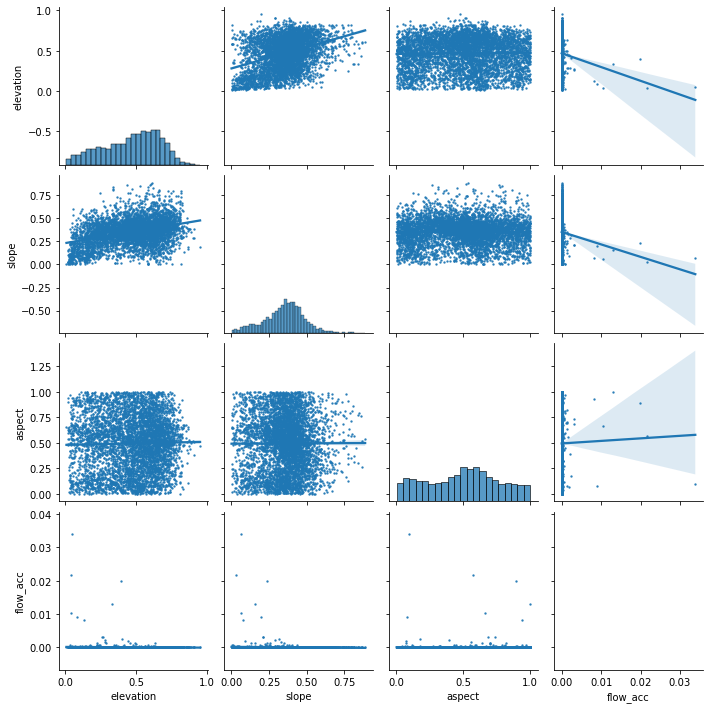
I’d like to do a variogram to check the spatial autorcorrelation but cant install skgstat
2.9.4. 4.0 Machine Learning
[26]:
import pandas as pd
import numpy as np
import rasterio
from rasterio import *
from rasterio.plot import show
from pyspatialml import Raster
from sklearn.ensemble import RandomForestRegressor
from sklearn.ensemble import RandomForestClassifier
from sklearn.model_selection import train_test_split,GridSearchCV
from sklearn.pipeline import Pipeline
from sklearn import metrics
from sklearn.metrics import confusion_matrix
from sklearn.metrics import ConfusionMatrixDisplay
from sklearn.metrics import roc_curve
from sklearn.metrics import RocCurveDisplay
from scipy.stats import pearsonr
import matplotlib.pyplot as plt
plt.rcParams["figure.figsize"] = (10,6.5)
import torch
from torch.utils.data.sampler import WeightedRandomSampler
from torch.utils.data import Dataset
from torch.utils.data import DataLoader
2.9.4.1. 4.1 Data set splitting
Split the dataset (balanced_data) in order to create response variable vs predictors variables.
[27]:
print(f"Number observations with 1: {balanced_data.loc[balanced_data['source']==1].shape}")
print(f"Number observations with 0: {balanced_data.loc[balanced_data['source']==0].shape}")
#print("Test data set")
#print(f"number of pixels with value 1: {np.count_nonzero(Y_test == 1)}")
#print(f"number of pixels with value 0: {np.count_nonzero(Y_test == 0)}")
Number observations with 1: (1663339, 7)
Number observations with 0: (1663339, 7)
I create a subset for the exploration phase
[28]:
subset = balanced_data[::10]
print(subset.shape)
#print(subset["source"].unique)
print("")
print(f"Number observations with 1: {subset.loc[subset['source']==1].shape}")
print(f"Number observations with 0: {subset.loc[subset['source']==0].shape}")
(332668, 7)
Number observations with 1: (166334, 7)
Number observations with 0: (166334, 7)
We separate the predictors in an independent dataframe
[29]:
#predictors = balanced_data.iloc[:,[3,4,5,6,7,8]]
#predictors = subset.iloc[:,[3,4,5,6,7,8]]
predictors = subset.iloc[:,[3,4,5,6]]
predictors.head()
[29]:
| elevation | slope | aspect | flow_acc | |
|---|---|---|---|---|
| 150961 | 0.595940 | 0.339840 | 0.396357 | 9.694714e-08 |
| 152105 | 0.593540 | 0.432921 | 0.523760 | 2.908414e-07 |
| 153248 | 0.592641 | 0.384547 | 0.392640 | 1.938943e-07 |
| 153258 | 0.592565 | 0.412114 | 0.568174 | 4.847357e-08 |
| 154403 | 0.590492 | 0.485489 | 0.506679 | 2.423678e-07 |
And we generate the target variable Y.
[30]:
#Y = balanced_data.iloc[:,2].values
Y = subset.iloc[:,2].values
#cols = balanced_data.iloc[:,[3,4,5,6,7,8]].columns.values
cols = subset.iloc[:,[3,4,5,6]].columns.values
[32]:
Y.shape
[32]:
(332668,)
[33]:
np.unique(Y)
[33]:
array([0, 1])
[34]:
class_sample_count = np.array(
[len(np.where(Y == t)[0]) for t in np.unique(Y)])
[35]:
print(class_sample_count)
[166334 166334]
Create 4 dataset for training and testing the algorithms
[36]:
predictors_train, predictors_test, Y_train, Y_test = train_test_split(predictors, Y, test_size=0.3, random_state=24)
y_train = np.ravel(Y_train)
y_test = np.ravel(Y_test)
predictors_train
[36]:
| elevation | slope | aspect | flow_acc | |
|---|---|---|---|---|
| 4543580 | 0.489895 | 0.416931 | 0.090972 | 2.423678e-07 |
| 31626453 | 0.623329 | 0.452705 | 0.609088 | 4.459568e-06 |
| 8014862 | 0.500084 | 0.343213 | 0.370626 | 7.271035e-07 |
| 12333889 | 0.351926 | 0.308792 | 0.002270 | 9.694714e-08 |
| 1119096 | 0.400774 | 0.096089 | 0.546268 | 1.216687e-05 |
| ... | ... | ... | ... | ... |
| 27937440 | 0.293026 | 0.271926 | 0.815419 | 1.420276e-05 |
| 13744240 | 0.237982 | 0.517935 | 0.433001 | 3.829412e-06 |
| 23266746 | 0.111182 | 0.117781 | 0.669988 | 4.847357e-08 |
| 460383 | 0.643240 | 0.338554 | 0.273997 | 1.163366e-06 |
| 10976443 | 0.665390 | 0.200948 | 0.046691 | 0.000000e+00 |
232867 rows × 4 columns
Verify that in both thaining and testing datasets the number of 0 and 1 is balanced.
[37]:
np.unique(Y_test)
print("Train data set")
print(f"number of pixels with value 1: {np.count_nonzero(Y_train == 1)}")
print(f"number of pixels with value 0: {np.count_nonzero(Y_train == 0)}")
Train data set
number of pixels with value 1: 116366
number of pixels with value 0: 116501
[38]:
np.unique(Y_test)
print("Test data set")
print(f"number of pixels with value 1: {np.count_nonzero(Y_test == 1)}")
print(f"number of pixels with value 0: {np.count_nonzero(Y_test == 0)}")
Test data set
number of pixels with value 1: 49968
number of pixels with value 0: 49833
2.9.4.2. 4.2 Random Forest
We want to generate a RF algorithm to predict the probability of being a debris flow source area.
Even though we are in a classification problem. We are going to use the Regression mode of the Random Forest.
First we are going to evaluating the optimal n_estimator value for the Random Forest
[ ]:
scores =[]
for k in range(20, 100):
rfReg = RandomForestClassifier(n_estimators=k,max_features=0..33,max_depth=150,max_samples=0.7,n_jobs=-1,random_state=24 , oob_score = True)
rfReg.fit(predictors_train, y_train);
dic_pred['test'] = rfReg.predict(predictors_test)
scores.append(metrics.accuracy_score(y_test, dic_pred['test']))
%matplotlib inline
plt.plot(range(20, 100), scores)
plt.xlabel('Value of n_estimators for Random Forest Classifier')
plt.ylabel('Prediction Accuracy')
[39]:
Image("/home/txomin/LVM_shared/Project/Figures/RF_optimization.png" , width = 500, height = 300)
[39]:
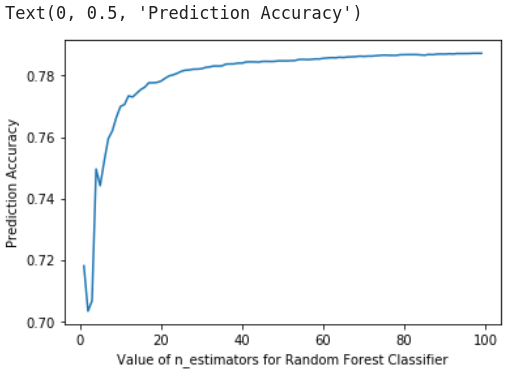
The model exploration phase gave the following conclusions:
n_estimators = 30 is the optimal parameter Let’s now run the final model
[40]:
rfReg = RandomForestRegressor(n_estimators=30,max_features=0.33,max_depth=150,max_samples=0.7,n_jobs=-1,random_state=24 , oob_score = True)
rfReg.fit(predictors_train, y_train);
dic_pred = {}
dic_pred['train'] = rfReg.predict(predictors_train)
dic_pred['test'] = rfReg.predict(predictors_test)
[41]:
dic_pred
[41]:
{'train': array([0.3780577 , 0.80381591, 0.747023 , ..., 0.02925411, 0.60093102,
0.05171677]),
'test': array([0.50321099, 0.02264603, 0.71128009, ..., 0.68730963, 0.77844419,
0.64082765])}
We generate a confusion matrix and a ROC curve in order to evaluate the performance of the model.
[42]:
y_pred = (dic_pred['train'] > 0.5).astype('float')
cm = confusion_matrix(y_train, y_pred, normalize = "true")
cm_display = ConfusionMatrixDisplay(cm).plot()
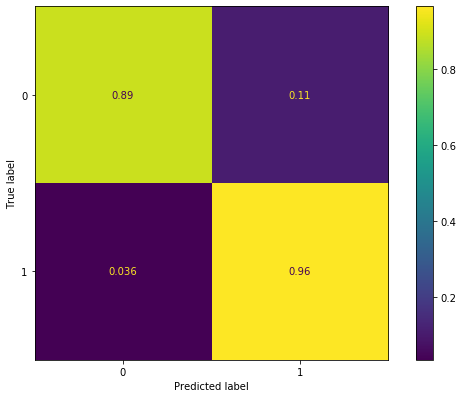
[43]:
#y_score = rfReg.decision_function(predictors_test)
fpr, tpr, _ = roc_curve(y_train,dic_pred['train'], pos_label=1)
roc_display = RocCurveDisplay(fpr=fpr, tpr=tpr).plot()
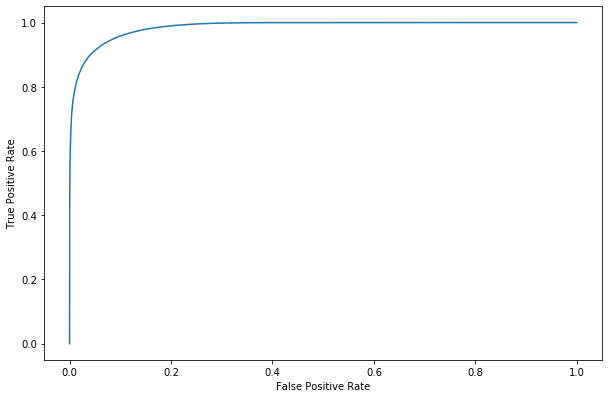
We can explore the organization of the results using the scatterplot.
[44]:
plt.rcParams["figure.figsize"] = (8,6)
plt.scatter(y_test,dic_pred['test'])
#plt.scatter(y_train,y_pred)
plt.xlabel('y_test')
plt.ylabel('y_predict')
ident = [0, 1]
plt.plot(ident,ident,'r--')
[44]:
[<matplotlib.lines.Line2D at 0x7ff9c322a820>]
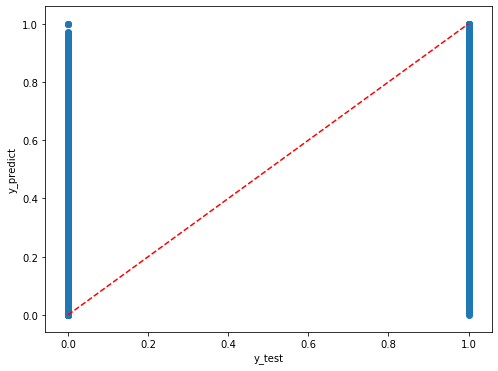
We can also have a look to the relevance of the used variables.
[45]:
impt = [rfReg.feature_importances_, np.std([tree.feature_importances_ for tree in rfReg.estimators_],axis=1)]
ind = np.argsort(impt[0])
[46]:
cols = clean_data_table.iloc[:,[3,4,5,6]].columns.values
plt.rcParams["figure.figsize"] = (10,5)
plt.barh(range(len(cols)),impt[0][ind],color="b", xerr=impt[1][ind], align="center")
plt.yticks(range(len(cols)),cols[ind]);
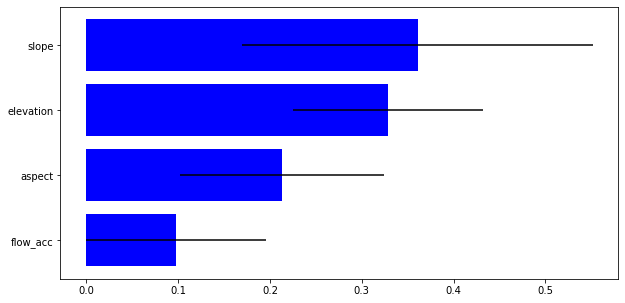
Now we can apply the generated model to the raster maps and obtain a susceptibility map
[ ]:
elevation = rasterio.open("/home/txomin/LVM_shared/Project/Valemount_data/Raster_variables/elevation.tif")
slope = rasterio.open("/home/txomin/LVM_shared/Project/Valemount_data/Raster_variables/slope.tif")
aspect = rasterio.open("/home/txomin/LVM_shared/Project/Valemount_data/Raster_variables/aspect.tif")
flow_acc = rasterio.open("/home/txomin/LVM_shared/Project/Valemount_data/Raster_variables/flow_acc.tif")
[ ]:
predictors_rasters = [elevation, slope, aspect, flow_acc]
stack = Raster(predictors_rasters)
[ ]:
result = stack.predict(estimator=rfReg, dtype='float64', nodata=-9999)
#result_proba = stack.predict_proba(estimator=rfReg, dtype='float32', nodata=-9999)
[ ]:
result.count
[ ]:
# plot regression result
plt.rcParams["figure.figsize"] = (12,12)
result.iloc[0].cmap = "plasma"
result.plot()
plt.show()
[ ]:
result.write('/home/txomin/LVM_shared/Project/Valemount_data/Raster_variables/source_prob.tif')
[47]:
from IPython.display import Image
Image("/home/txomin/LVM_shared/Project/Figures/RfRegressor_map.png" , width = 800, height = 500)
[47]:
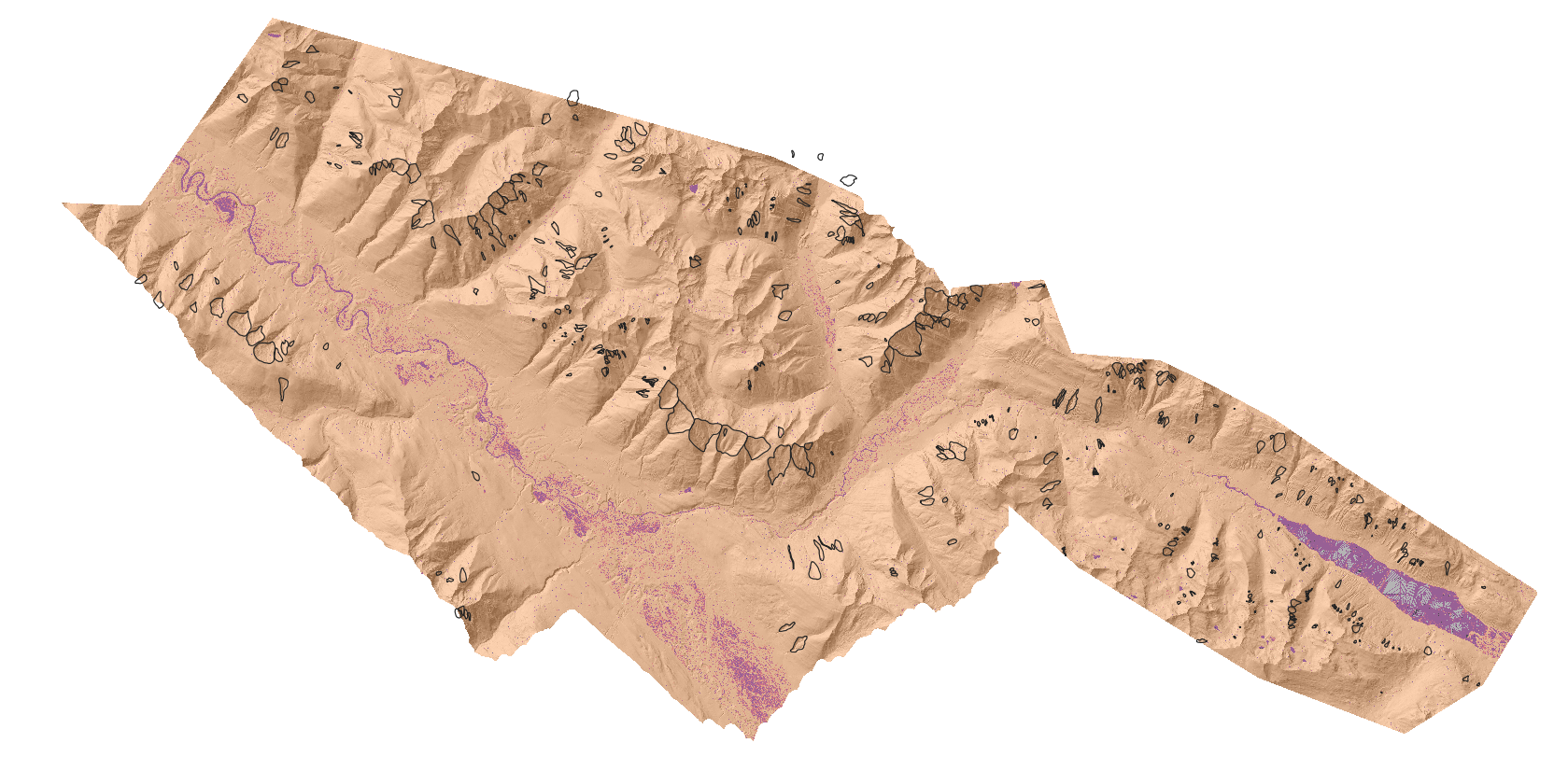
2.9.4.3. 4.3 Support Vector Machine for Regression (SVR)
We are going to try to apply the SVM Regressor to the same dataset.
[10]:
import pandas as pd
import numpy as np
from sklearn.model_selection import train_test_split
from sklearn.preprocessing import MinMaxScaler
from sklearn.svm import SVR
We can plot a scatter plot of the most potential variables [elevation and slope] to observe if there is a clustering.
[49]:
plt.scatter(subset["elevation"], subset["slope"],c=subset["source"],alpha=0.5)
plt.title('Linearly separable data?')
plt.xlabel('elevation')
plt.ylabel('slope')
plt.show()
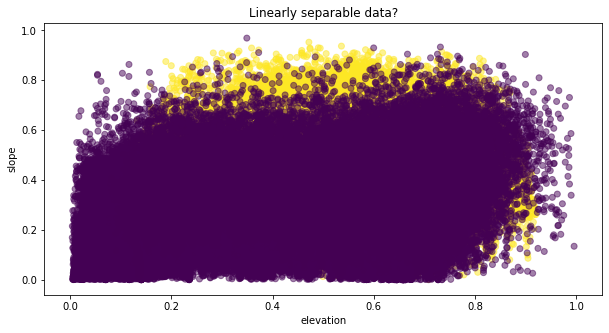
We create a much smaller subset for the exploration phase in order to avoid very long computational time.
[11]:
subset_100 = balanced_data[::100]
print(subset_100.shape)
#print(subset["source"].unique)
print("")
print(f"Number observations with 1: {subset_100.loc[subset_100['source']==1].shape}")
print(f"Number observations with 0: {subset_100.loc[subset_100['source']==0].shape}")
(33267, 7)
Number observations with 1: (16634, 7)
Number observations with 0: (16633, 7)
We can save the subset table to use it directly in case of computer crash, and avoid all the previous steps.
[12]:
subset_100.to_csv("/home/txomin/LVM_shared/Project/Valemount_data/subset_100.txt", header="True", sep=' ', mode='a')
#subset_100.write("/home/txomin/LVM_shared/Project/Valemount_data/subset_100.txt")#
[ ]:
table = pd.read_csv("/home/txomin/LVM_shared/Project/Valemount_data/subset_100.txt", sep=" ", index_col=False)
table.head()
So, we have to split the data again in training and test subsets
[13]:
#predictors = balanced_data.iloc[:,[3,4,5,6,7,8]]
#predictors = subset.iloc[:,[3,4,5,6,7,8]]
predictors = subset_100.iloc[:,[3,4,5,6]]
predictors.head()
[13]:
| elevation | slope | aspect | flow_acc | |
|---|---|---|---|---|
| 150961 | 0.595940 | 0.339840 | 0.396357 | 9.694714e-08 |
| 157876 | 0.584775 | 0.405498 | 0.448568 | 3.393150e-07 |
| 162557 | 0.588556 | 0.386079 | 0.216777 | 5.332093e-07 |
| 166125 | 0.576947 | 0.519611 | 0.280226 | 1.502681e-06 |
| 169719 | 0.594458 | 0.375756 | 0.173641 | 0.000000e+00 |
[14]:
#Y = balanced_data.iloc[:,2].values
Y = subset_100.iloc[:,2].values
#cols = balanced_data.iloc[:,[3,4,5,6,7,8]].columns.values
cols = subset_100.iloc[:,[3,4,5,6]].columns.values
[15]:
predictors_train, predictors_test, Y_train, Y_test = train_test_split(predictors, Y, test_size=0.3, random_state=24)
y_train = np.ravel(Y_train)
y_test = np.ravel(Y_test)
predictors_train
[15]:
| elevation | slope | aspect | flow_acc | |
|---|---|---|---|---|
| 23310647 | 0.069639 | 0.157875 | 0.646518 | 1.454207e-07 |
| 11105549 | 0.680895 | 0.449267 | 0.775413 | 1.017945e-06 |
| 25188622 | 0.538591 | 0.373464 | 0.739144 | 5.332093e-07 |
| 16704940 | 0.645838 | 0.552962 | 0.479199 | 9.209978e-07 |
| 17419574 | 0.476822 | 0.447592 | 0.485196 | 5.816828e-07 |
| ... | ... | ... | ... | ... |
| 15256488 | 0.655266 | 0.781469 | 0.503718 | 1.454207e-07 |
| 15886672 | 0.536405 | 0.397595 | 0.151926 | 1.017945e-06 |
| 11527887 | 0.420302 | 0.407068 | 0.675394 | 4.847357e-08 |
| 30547721 | 0.544867 | 0.266243 | 0.684146 | 5.816828e-07 |
| 2970286 | 0.569260 | 0.714146 | 0.611796 | 7.755771e-07 |
23286 rows × 4 columns
[55]:
print(predictors_train.shape)
print(y_train.shape)
(23286, 4)
(23286,)
We can explore the optimal Regularization value.
[16]:
for n in np.arange(1,11):
svr = SVR(C=n, kernel="rbf")
svr.fit(predictors_train, y_train) # Fit the SVR model according to the given training data.
print(f"Regularization C = {n} and kernel = rbf")
print('Accuracy of SVR on training set: {:.5f}'.format(svr.score(predictors_train, y_train))) # Returns the coefficient of determination (R^2) of the prediction.
print('Accuracy of SVR on test set: {:.5f}'.format(svr.score(predictors_test, y_test)))
print("")
Regularization C = 1 and kernel = rbf
Accuracy of SVR on training set: 0.24024
Accuracy of SVR on test set: 0.24185
Regularization C = 2 and kernel = rbf
Accuracy of SVR on training set: 0.24128
Accuracy of SVR on test set: 0.24294
Regularization C = 3 and kernel = rbf
Accuracy of SVR on training set: 0.24102
Accuracy of SVR on test set: 0.24268
Regularization C = 4 and kernel = rbf
Accuracy of SVR on training set: 0.24143
Accuracy of SVR on test set: 0.24291
Regularization C = 5 and kernel = rbf
Accuracy of SVR on training set: 0.24151
Accuracy of SVR on test set: 0.24282
Regularization C = 6 and kernel = rbf
Accuracy of SVR on training set: 0.24164
Accuracy of SVR on test set: 0.24309
Regularization C = 7 and kernel = rbf
Accuracy of SVR on training set: 0.24169
Accuracy of SVR on test set: 0.24309
Regularization C = 8 and kernel = rbf
Accuracy of SVR on training set: 0.24158
Accuracy of SVR on test set: 0.24296
Regularization C = 9 and kernel = rbf
Accuracy of SVR on training set: 0.24154
Accuracy of SVR on test set: 0.24285
Regularization C = 10 and kernel = rbf
Accuracy of SVR on training set: 0.24111
Accuracy of SVR on test set: 0.24226
[56]:
svr = SVR(C=4, kernel="rbf")
svr.fit(predictors_train, y_train) # Fit the SVR model according to the given training data.
print('Accuracy of SVR on training set: {:.5f}'.format(svr.score(predictors_train, y_train))) # Returns the coefficient of determination (R^2) of the prediction.
print('Accuracy of SVR on test set: {:.5f}'.format(svr.score(predictors_test, y_test)))
Accuracy of SVR on training set: 0.24744
Accuracy of SVR on test set: 0.23693
[57]:
svr_pred = {}
svr_pred['train'] = svr.predict(predictors_train)
svr_pred['test'] = svr.predict(predictors_test)
[58]:
print(f"range prediction train: {np.min(svr_pred['train'])} -- {np.max(svr_pred['train'])}")
print(f"range prediction test: {np.min(svr_pred['test'])} -- {np.max(svr_pred['test'])}")
range prediction train: -0.6247238892601716 -- 1.2884218089203205
range prediction test: -1.1966206427227377 -- 1.1193402180140222
The resulting values are in the range of -1.2 and 1.3.
In order to represent the susceptibility these values should be passed by a SIGMOIDAL function.
def sig_func(x):
return 1 / (1 + np.exp(-x))output = sig_func(input)
print(output)
The following commands block is the repetition of the block ran in the Random Forest section.
It is not ras because it takes a lot of time.
[ ]:
#del original_data_table
#del clean_data_table
[ ]:
elevation = rasterio.open("/home/txomin/LVM_shared/Project/Valemount_data/Raster_variables/elevation.tif")
slope = rasterio.open("/home/txomin/LVM_shared/Project/Valemount_data/Raster_variables/slope.tif")
aspect = rasterio.open("/home/txomin/LVM_shared/Project/Valemount_data/Raster_variables/aspect.tif")
flow_acc = rasterio.open("/home/txomin/LVM_shared/Project/Valemount_data/Raster_variables/flow_acc.tif")
[ ]:
predictors_rasters = [elevation, slope, aspect, flow_acc]
stack = Raster(predictors_rasters)
[ ]:
result = stack.predict(estimator=svr, dtype='float32', nodata=-9999)
#result_proba = stack.predict_proba(estimator=rfReg, dtype='float32', nodata=-9999)
[ ]:
result.count
[ ]:
# plot regression result
plt.rcParams["figure.figsize"] = (12,12)
result.iloc[0].cmap = "plasma"
result.plot()
plt.show()
[ ]:
result.write('/home/txomin/LVM_shared/Project/Valemount_data/Raster_variables/source_prob_svm.tif')
2.9.5. Multilayer Perceptron (MP)
[14]:
import os
import torch
import torch.nn as nn
import numpy as np
import matplotlib.pyplot as plt
import scipy
import pandas as pd
from sklearn.metrics import r2_score
from sklearn.model_selection import train_test_split
Upload the data
[16]:
subset_100 = pd.read_csv("/home/txomin/LVM_shared/Project/Valemount_data/subset_100.txt", sep=" ", index_col=False)
subset_100 = subset_100.iloc[:,1:]
subset_100.head()
<ipython-input-16-d056b02f7cc8>:1: DtypeWarning: Columns (1,2,3,4,5,6,7) have mixed types. Specify dtype option on import or set low_memory=False.
subset_100 = pd.read_csv("/home/txomin/LVM_shared/Project/Valemount_data/subset_100.txt", sep=" ", index_col=False)
[16]:
| X | Y | source | elevation | slope | aspect | flow_acc | |
|---|---|---|---|---|---|---|---|
| 0 | 319961.46 | 5894608.235 | 1 | 0.5959395648681869 | 0.33984028646546643 | 0.39635665654626817 | 9.694713942680682e-08 |
| 1 | 319986.46 | 5894578.235 | 1 | 0.5847746934629892 | 0.4054976013231919 | 0.4485679126886464 | 3.393149879938239e-07 |
| 2 | 319961.46 | 5894558.235 | 1 | 0.5885562671182469 | 0.3860789794735605 | 0.21677699104719736 | 5.332092668474375e-07 |
| 3 | 319991.46 | 5894543.235 | 1 | 0.5769465046947835 | 0.5196114051142899 | 0.28022577840494 | 1.502680661115506e-06 |
| 4 | 319951.46 | 5894528.235 | 1 | 0.5944581724350257 | 0.3757564187183976 | 0.17364076011322255 | 0.0 |
[3]:
#predictors = balanced_data.iloc[:,[3,4,5,6,7,8]]
#predictors = subset.iloc[:,[3,4,5,6,7,8]]
predictors = subset_100.iloc[:,[3,4,5,6]]
predictors.head()
[3]:
| elevation | slope | aspect | flow_acc | |
|---|---|---|---|---|
| 0 | 0.5959395648681869 | 0.33984028646546643 | 0.39635665654626817 | 9.694713942680682e-08 |
| 1 | 0.5847746934629892 | 0.4054976013231919 | 0.4485679126886464 | 3.393149879938239e-07 |
| 2 | 0.5885562671182469 | 0.3860789794735605 | 0.21677699104719736 | 5.332092668474375e-07 |
| 3 | 0.5769465046947835 | 0.5196114051142899 | 0.28022577840494 | 1.502680661115506e-06 |
| 4 | 0.5944581724350257 | 0.3757564187183976 | 0.17364076011322255 | 0.0 |
[4]:
#Y = balanced_data.iloc[:,2].values
Y = subset_100.iloc[:,2].values
#cols = balanced_data.iloc[:,[3,4,5,6,7,8]].columns.values
cols = subset_100.iloc[:,[3,4,5,6]].columns.values
[5]:
predictors_train, predictors_test, Y_train, Y_test = train_test_split(predictors, Y, test_size=0.3, random_state=24)
y_train = np.ravel(Y_train)
y_test = np.ravel(Y_test)
predictors_train
[5]:
| elevation | slope | aspect | flow_acc | |
|---|---|---|---|---|
| 17990 | 0.11525091143497707 | 0.3014757442257044 | 0.9190747752077089 | 4.8473569713403414e-08 |
| 6084 | 0.45213564253858607 | 0.41195135304574293 | 0.2594462762396562 | 9.694713942680682e-08 |
| 30356 | 0.047089347841828944 | 0.0844628640367968 | 0.5593959983222175 | 2.4236784856701703e-07 |
| 48802 | 0.3844459473977899 | 0.44209180775710577 | 0.8939580387723299 | 5.816828365608409e-07 |
| 47361 | 0.4474784854963162 | 0.37815434602508763 | 0.4812041144558735 | 6.301564062742443e-07 |
| ... | ... | ... | ... | ... |
| 12411 | 0.5962614009239535 | 0.39583590474441815 | 0.44982347173186593 | 2.9084141828042046e-07 |
| 6500 | 0.6552662554422242 | 0.7814685090057648 | 0.5037180658835163 | 1.4542070914021023e-07 |
| 21633 | 0.649212897863908 | 0.17937305630231787 | 0.923235897877494 | 3.393149879938239e-07 |
| 59537 | 0.1984625702300702 | 0.31834958006278136 | 0.7250297917494215 | 2.472152055383574e-06 |
| 899 | 0.569260302421769 | 0.7141464130370311 | 0.6117961438781775 | 7.755771154144546e-07 |
46574 rows × 4 columns
[6]:
print(predictors_train.shape)
print(y_train.shape)
(46574, 4)
(46574,)
[7]:
print("Train data set")
print(f"number of pixels with value 1: {np.count_nonzero(Y_train == 1)}")
print(f"number of pixels with value 0: {np.count_nonzero(Y_train == 0)}")
Train data set
number of pixels with value 1: 0
number of pixels with value 0: 691
[8]:
print("Test data set")
print(f"number of pixels with value 1: {np.count_nonzero(Y_test == 1)}")
print(f"number of pixels with value 0: {np.count_nonzero(Y_test == 0)}")
Test data set
number of pixels with value 1: 0
number of pixels with value 0: 308
In order to convert the predictors data frame to the Torch data, first they have to be transformed into numpy.
[12]:
type(predictors_train)
[12]:
pandas.core.frame.DataFrame
[10]:
Predictors_train = predictors_train.to_numpy()
Predictors_test = predictors_test.to_numpy()
[13]:
type(Predictors_train)
[13]:
numpy.ndarray
[ ]:
predictors_train = torch.FloatTensor(Predictors_train)
y_train = torch.FloatTensor(y_train)
predictors_test = torch.FloatTensor(Predictors_test)
y_test = torch.FloatTensor(y_test)
The objective is to run a Feed Forward Neural Network with the following parameters: * Mean Square Error (MSE) as a the evaluation criterion * Stochastic Gradient Descent (SGD) as the optimizer function * 1000 Epochs * Dimention Ranges 5, 25, 50, 100 * Lerning Rate values 0.75, 0.5, 0.1, 0.01, 0.05, 0.001 * Two hidden layers * Sigmoidal final activation function
[56]:
# Try with FF
class Feedforward(torch.nn.Module):
def __init__(self, input_size, hidden_size, output_size=1):
super(Feedforward, self).__init__()
self.input_size = input_size
self.hidden_size = hidden_size
self.fc1 = torch.nn.Linear(self.input_size, self.hidden_size)
self.fc2 = torch.nn.Linear(self.hidden_size, self.hidden_size)
# self.fc3 = torch.nn.Linear(self.hidden_size, self.hidden_size)
# self.fc4 = torch.nn.Linear(self.hidden_size, self.hidden_size)
self.relu = torch.nn.ReLU()
self.fc3 = torch.nn.Linear(self.hidden_size, output_size)
self.sigmoid = torch.nn.Sigmoid()
self.tanh = torch.nn.Tanh()
def forward(self, x):
hidden = self.relu(self.fc1(x))
hidden = self.sigmoid(self.fc2(hidden))
output = self.sigmoid(self.fc3(hidden))
# hidden = self.relu(self.fc4(hidden))
#output = self.sigmoid(self.fc3(hidden))
return output
[57]:
# model.train()
epochs = 1000
hid_dim_range = [5,25,50,100]
#hid_dim_range = [5,25]
lr_range = [0.75,0.5,0.1,0.01,0.05,0.001]
#lr_range = [0.75,0.5]
#Let's create a place to save these models, so we can
path_to_save_models = './models'
if not os.path.exists(path_to_save_models):
os.makedirs(path_to_save_models)
for hid_dim in hid_dim_range:
for lr in lr_range:
print('\nhid_dim: {}, lr: {}'.format(hid_dim, lr))
if 'model' in globals():
print('Deleting previous model')
del model, criterion, optimizer
model = Feedforward(4, hid_dim)
criterion = torch.nn.MSELoss()
optimizer = torch.optim.SGD(model.parameters(), lr = lr)
#optimizer = torch.optim.SGD(model.parameters(), lr = lr)
all_loss_train=[]
all_loss_val=[]
for epoch in range(epochs):
model.train()
optimizer.zero_grad()
# Forward pass
y_pred = model(predictors_train)
# Compute Loss
loss = criterion(y_pred.squeeze(), y_train)
# Backward pass
loss.backward()
optimizer.step()
all_loss_train.append(loss.item())
model.eval()
with torch.no_grad():
y_pred = model(predictors_test)
# Compute Loss
loss = criterion(y_pred.squeeze(), y_test)
all_loss_val.append(loss.item())
if epoch%100==0:
y_pred = y_pred.detach().numpy().squeeze()
slope, intercept, r_value, p_value, std_err = scipy.stats.linregress(y_pred, y_test)
print('Epoch {}, train_loss: {:.4f}, val_loss: {:.4f}, r_value: {:.4f}'.format(epoch,all_loss_train[-1],all_loss_val[-1],r_value))
fig,ax=plt.subplots(1,2,figsize=(10,5))
ax[0].plot(np.log10(all_loss_train))
ax[0].plot(np.log10(all_loss_val))
ax[1].scatter(y_pred, y_test)
ax[1].set_xlabel('Prediction')
ax[1].set_ylabel('True')
ax[1].set_title('slope: {:.4f}, r_value: {:.4f}'.format(slope, r_value))
plt.show()
name_to_save = os.path.join(path_to_save_models,'model_SGD_' + str(epochs) + '_lr' + str(lr) + '_hid_dim' + str(hid_dim))
print('Saving model to ', name_to_save)
model_state = {
'epoch': epoch + 1,
'state_dict': model.state_dict(),
'optimizer' : optimizer.state_dict(),
}
torch.save(model_state, name_to_save +'.pt')
hid_dim: 5, lr: 0.75
Deleting previous model
Epoch 0, train_loss: 0.2500, val_loss: 0.2500, r_value: -0.0655
Epoch 100, train_loss: 0.2500, val_loss: 0.2500, r_value: -0.0550
Epoch 200, train_loss: 0.2500, val_loss: 0.2500, r_value: -0.0469
Epoch 300, train_loss: 0.2500, val_loss: 0.2500, r_value: -0.0265
Epoch 400, train_loss: 0.2500, val_loss: 0.2500, r_value: 0.0578
Epoch 500, train_loss: 0.2500, val_loss: 0.2500, r_value: 0.0567
Epoch 600, train_loss: 0.2500, val_loss: 0.2500, r_value: 0.0626
Epoch 700, train_loss: 0.2500, val_loss: 0.2500, r_value: 0.0730
Epoch 800, train_loss: 0.2500, val_loss: 0.2500, r_value: 0.0885
Epoch 900, train_loss: 0.2499, val_loss: 0.2499, r_value: 0.1086
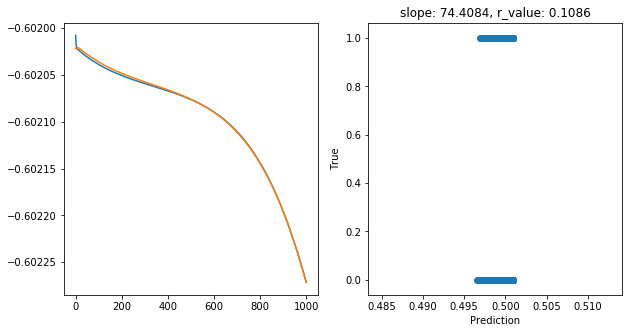
Saving model to ./models/model_SGD_1000_lr0.75_hid_dim5
hid_dim: 5, lr: 0.5
Deleting previous model
Epoch 0, train_loss: 0.2619, val_loss: 0.2595, r_value: -0.0813
Epoch 100, train_loss: 0.2500, val_loss: 0.2499, r_value: 0.0514
Epoch 200, train_loss: 0.2498, val_loss: 0.2498, r_value: 0.2299
Epoch 300, train_loss: 0.2496, val_loss: 0.2495, r_value: 0.3505
Epoch 400, train_loss: 0.2493, val_loss: 0.2492, r_value: 0.4086
Epoch 500, train_loss: 0.2488, val_loss: 0.2487, r_value: 0.4348
Epoch 600, train_loss: 0.2478, val_loss: 0.2478, r_value: 0.4476
Epoch 700, train_loss: 0.2459, val_loss: 0.2459, r_value: 0.4538
Epoch 800, train_loss: 0.2418, val_loss: 0.2417, r_value: 0.4563
Epoch 900, train_loss: 0.2334, val_loss: 0.2333, r_value: 0.4573
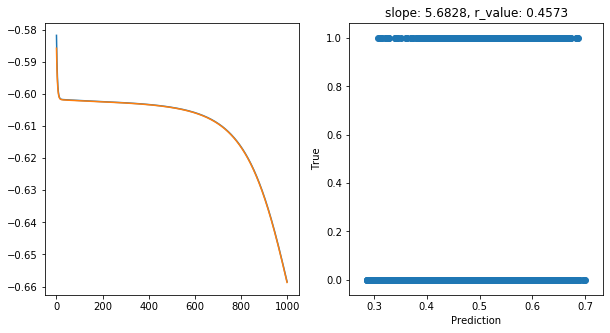
Saving model to ./models/model_SGD_1000_lr0.5_hid_dim5
hid_dim: 5, lr: 0.1
Deleting previous model
Epoch 0, train_loss: 0.2509, val_loss: 0.2508, r_value: -0.2765
Epoch 100, train_loss: 0.2507, val_loss: 0.2506, r_value: -0.2542
Epoch 200, train_loss: 0.2505, val_loss: 0.2505, r_value: -0.2279
Epoch 300, train_loss: 0.2504, val_loss: 0.2504, r_value: -0.1961
Epoch 400, train_loss: 0.2503, val_loss: 0.2503, r_value: -0.1570
Epoch 500, train_loss: 0.2502, val_loss: 0.2502, r_value: -0.1084
Epoch 600, train_loss: 0.2501, val_loss: 0.2501, r_value: -0.0482
Epoch 700, train_loss: 0.2500, val_loss: 0.2500, r_value: 0.0248
Epoch 800, train_loss: 0.2499, val_loss: 0.2499, r_value: 0.1088
Epoch 900, train_loss: 0.2498, val_loss: 0.2498, r_value: 0.1972
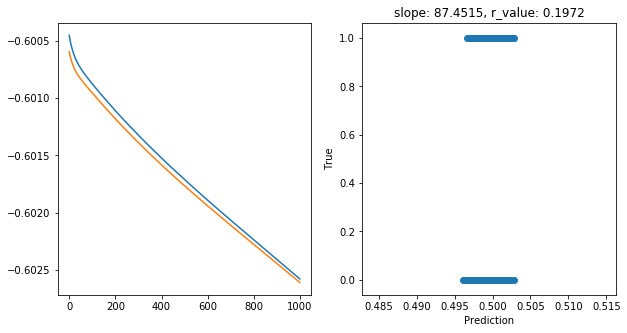
Saving model to ./models/model_SGD_1000_lr0.1_hid_dim5
hid_dim: 5, lr: 0.01
Deleting previous model
Epoch 0, train_loss: 0.2496, val_loss: 0.2496, r_value: 0.2356
Epoch 100, train_loss: 0.2496, val_loss: 0.2496, r_value: 0.2371
Epoch 200, train_loss: 0.2496, val_loss: 0.2496, r_value: 0.2385
Epoch 300, train_loss: 0.2496, val_loss: 0.2496, r_value: 0.2400
Epoch 400, train_loss: 0.2496, val_loss: 0.2496, r_value: 0.2414
Epoch 500, train_loss: 0.2496, val_loss: 0.2496, r_value: 0.2428
Epoch 600, train_loss: 0.2496, val_loss: 0.2496, r_value: 0.2443
Epoch 700, train_loss: 0.2496, val_loss: 0.2496, r_value: 0.2457
Epoch 800, train_loss: 0.2496, val_loss: 0.2496, r_value: 0.2471
Epoch 900, train_loss: 0.2496, val_loss: 0.2496, r_value: 0.2486
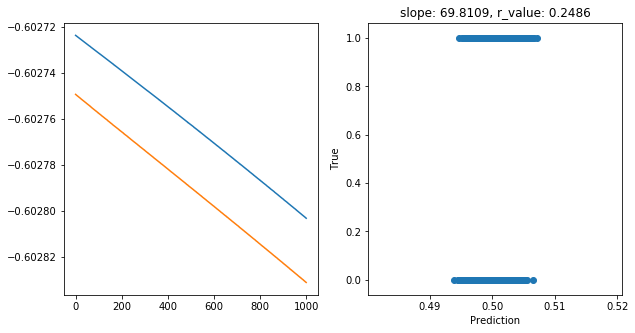
Saving model to ./models/model_SGD_1000_lr0.01_hid_dim5
hid_dim: 5, lr: 0.05
Deleting previous model
Epoch 0, train_loss: 0.2759, val_loss: 0.2749, r_value: 0.3544
Epoch 100, train_loss: 0.2512, val_loss: 0.2511, r_value: 0.3689
Epoch 200, train_loss: 0.2491, val_loss: 0.2491, r_value: 0.3788
Epoch 300, train_loss: 0.2489, val_loss: 0.2489, r_value: 0.3851
Epoch 400, train_loss: 0.2488, val_loss: 0.2489, r_value: 0.3897
Epoch 500, train_loss: 0.2488, val_loss: 0.2488, r_value: 0.3932
Epoch 600, train_loss: 0.2487, val_loss: 0.2487, r_value: 0.3962
Epoch 700, train_loss: 0.2486, val_loss: 0.2486, r_value: 0.3989
Epoch 800, train_loss: 0.2485, val_loss: 0.2486, r_value: 0.4013
Epoch 900, train_loss: 0.2484, val_loss: 0.2485, r_value: 0.4035
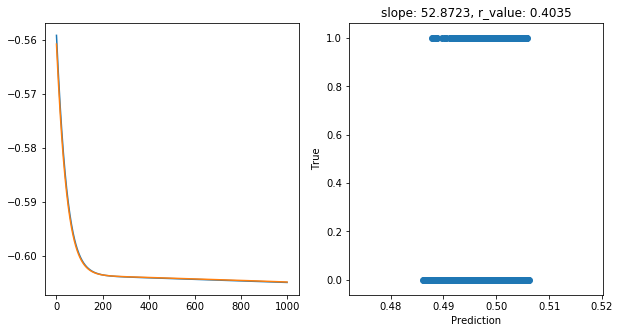
Saving model to ./models/model_SGD_1000_lr0.05_hid_dim5
hid_dim: 5, lr: 0.001
Deleting previous model
Epoch 0, train_loss: 0.2577, val_loss: 0.2574, r_value: -0.0997
Epoch 100, train_loss: 0.2573, val_loss: 0.2570, r_value: -0.0989
Epoch 200, train_loss: 0.2570, val_loss: 0.2567, r_value: -0.0981
Epoch 300, train_loss: 0.2566, val_loss: 0.2563, r_value: -0.0974
Epoch 400, train_loss: 0.2563, val_loss: 0.2560, r_value: -0.0967
Epoch 500, train_loss: 0.2560, val_loss: 0.2557, r_value: -0.0960
Epoch 600, train_loss: 0.2557, val_loss: 0.2554, r_value: -0.0953
Epoch 700, train_loss: 0.2554, val_loss: 0.2551, r_value: -0.0947
Epoch 800, train_loss: 0.2551, val_loss: 0.2548, r_value: -0.0940
Epoch 900, train_loss: 0.2548, val_loss: 0.2546, r_value: -0.0934
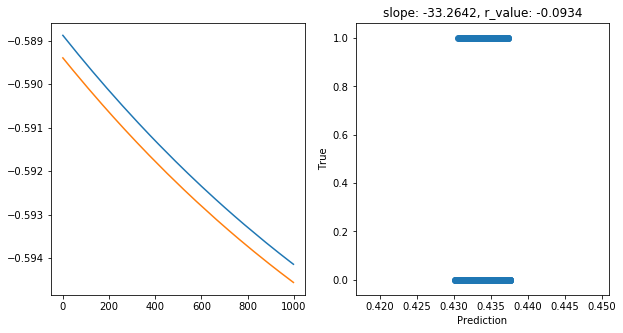
Saving model to ./models/model_SGD_1000_lr0.001_hid_dim5
hid_dim: 25, lr: 0.75
Deleting previous model
Epoch 0, train_loss: 0.2507, val_loss: 0.2501, r_value: -0.0051
Epoch 100, train_loss: 0.2493, val_loss: 0.2493, r_value: 0.3616
Epoch 200, train_loss: 0.2478, val_loss: 0.2478, r_value: 0.4514
Epoch 300, train_loss: 0.2432, val_loss: 0.2432, r_value: 0.4593
Epoch 400, train_loss: 0.2265, val_loss: 0.2265, r_value: 0.4595
Epoch 500, train_loss: 0.2008, val_loss: 0.2009, r_value: 0.4712
Epoch 600, train_loss: 0.1923, val_loss: 0.1918, r_value: 0.4889
Epoch 700, train_loss: 0.1891, val_loss: 0.1881, r_value: 0.5002
Epoch 800, train_loss: 0.1878, val_loss: 0.1865, r_value: 0.5055
Epoch 900, train_loss: 0.1872, val_loss: 0.1857, r_value: 0.5081
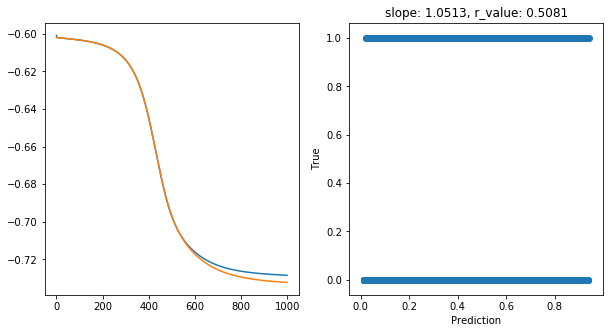
Saving model to ./models/model_SGD_1000_lr0.75_hid_dim25
hid_dim: 25, lr: 0.5
Deleting previous model
Epoch 0, train_loss: 0.2522, val_loss: 0.2507, r_value: 0.0599
Epoch 100, train_loss: 0.2484, val_loss: 0.2485, r_value: 0.3156
Epoch 200, train_loss: 0.2459, val_loss: 0.2459, r_value: 0.3704
Epoch 300, train_loss: 0.2403, val_loss: 0.2403, r_value: 0.4001
Epoch 400, train_loss: 0.2279, val_loss: 0.2278, r_value: 0.4253
Epoch 500, train_loss: 0.2112, val_loss: 0.2113, r_value: 0.4469
Epoch 600, train_loss: 0.2002, val_loss: 0.2002, r_value: 0.4655
Epoch 700, train_loss: 0.1947, val_loss: 0.1944, r_value: 0.4800
Epoch 800, train_loss: 0.1916, val_loss: 0.1910, r_value: 0.4905
Epoch 900, train_loss: 0.1898, val_loss: 0.1889, r_value: 0.4972
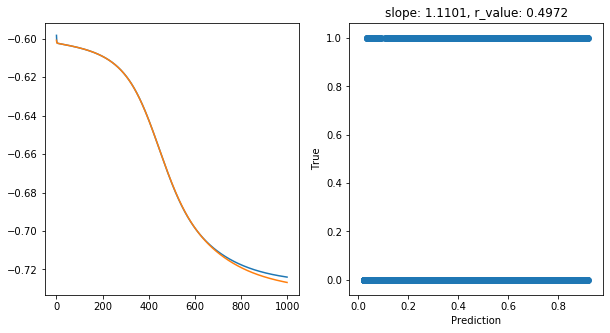
Saving model to ./models/model_SGD_1000_lr0.5_hid_dim25
hid_dim: 25, lr: 0.1
Deleting previous model
Epoch 0, train_loss: 0.2612, val_loss: 0.2596, r_value: 0.0976
Epoch 100, train_loss: 0.2499, val_loss: 0.2499, r_value: 0.1158
Epoch 200, train_loss: 0.2498, val_loss: 0.2498, r_value: 0.2804
Epoch 300, train_loss: 0.2497, val_loss: 0.2497, r_value: 0.3816
Epoch 400, train_loss: 0.2495, val_loss: 0.2495, r_value: 0.4285
Epoch 500, train_loss: 0.2494, val_loss: 0.2494, r_value: 0.4482
Epoch 600, train_loss: 0.2492, val_loss: 0.2492, r_value: 0.4562
Epoch 700, train_loss: 0.2491, val_loss: 0.2490, r_value: 0.4592
Epoch 800, train_loss: 0.2489, val_loss: 0.2489, r_value: 0.4600
Epoch 900, train_loss: 0.2487, val_loss: 0.2486, r_value: 0.4599
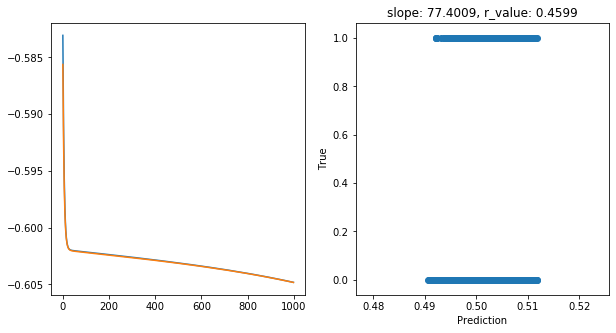
Saving model to ./models/model_SGD_1000_lr0.1_hid_dim25
hid_dim: 25, lr: 0.01
Deleting previous model
Epoch 0, train_loss: 0.2500, val_loss: 0.2500, r_value: 0.4148
Epoch 100, train_loss: 0.2497, val_loss: 0.2497, r_value: 0.4202
Epoch 200, train_loss: 0.2496, val_loss: 0.2496, r_value: 0.4252
Epoch 300, train_loss: 0.2496, val_loss: 0.2496, r_value: 0.4293
Epoch 400, train_loss: 0.2496, val_loss: 0.2496, r_value: 0.4325
Epoch 500, train_loss: 0.2495, val_loss: 0.2495, r_value: 0.4350
Epoch 600, train_loss: 0.2495, val_loss: 0.2495, r_value: 0.4369
Epoch 700, train_loss: 0.2494, val_loss: 0.2494, r_value: 0.4383
Epoch 800, train_loss: 0.2494, val_loss: 0.2494, r_value: 0.4395
Epoch 900, train_loss: 0.2494, val_loss: 0.2494, r_value: 0.4405
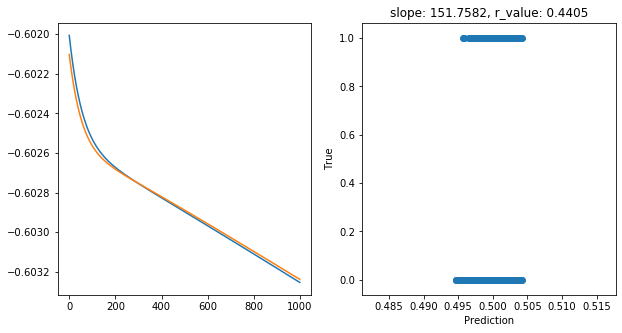
Saving model to ./models/model_SGD_1000_lr0.01_hid_dim25
hid_dim: 25, lr: 0.05
Deleting previous model
Epoch 0, train_loss: 0.2612, val_loss: 0.2606, r_value: -0.0994
Epoch 100, train_loss: 0.2500, val_loss: 0.2500, r_value: 0.0553
Epoch 200, train_loss: 0.2499, val_loss: 0.2499, r_value: 0.1630
Epoch 300, train_loss: 0.2499, val_loss: 0.2498, r_value: 0.2430
Epoch 400, train_loss: 0.2498, val_loss: 0.2498, r_value: 0.2966
Epoch 500, train_loss: 0.2497, val_loss: 0.2497, r_value: 0.3314
Epoch 600, train_loss: 0.2497, val_loss: 0.2497, r_value: 0.3543
Epoch 700, train_loss: 0.2496, val_loss: 0.2496, r_value: 0.3696
Epoch 800, train_loss: 0.2495, val_loss: 0.2495, r_value: 0.3802
Epoch 900, train_loss: 0.2494, val_loss: 0.2494, r_value: 0.3878
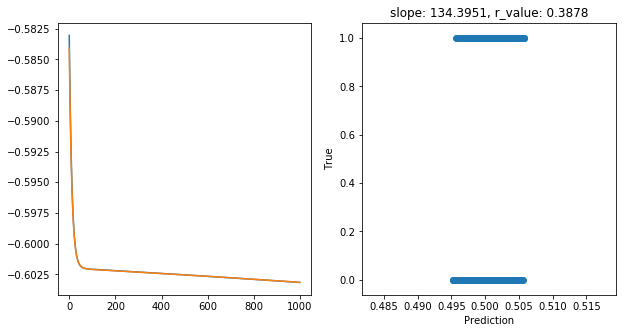
Saving model to ./models/model_SGD_1000_lr0.05_hid_dim25
hid_dim: 25, lr: 0.001
Deleting previous model
Epoch 0, train_loss: 0.2507, val_loss: 0.2507, r_value: -0.4030
Epoch 100, train_loss: 0.2507, val_loss: 0.2507, r_value: -0.4026
Epoch 200, train_loss: 0.2507, val_loss: 0.2507, r_value: -0.4022
Epoch 300, train_loss: 0.2507, val_loss: 0.2507, r_value: -0.4018
Epoch 400, train_loss: 0.2507, val_loss: 0.2507, r_value: -0.4014
Epoch 500, train_loss: 0.2507, val_loss: 0.2507, r_value: -0.4010
Epoch 600, train_loss: 0.2507, val_loss: 0.2507, r_value: -0.4005
Epoch 700, train_loss: 0.2507, val_loss: 0.2507, r_value: -0.4001
Epoch 800, train_loss: 0.2507, val_loss: 0.2507, r_value: -0.3996
Epoch 900, train_loss: 0.2507, val_loss: 0.2507, r_value: -0.3991
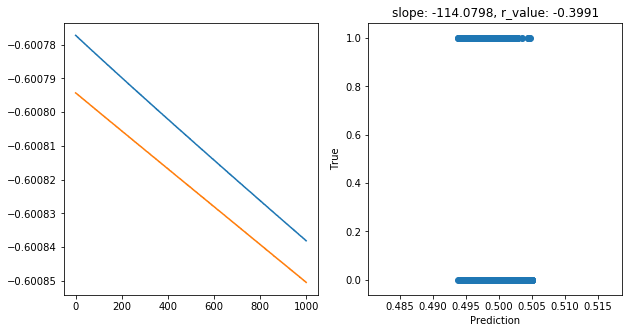
Saving model to ./models/model_SGD_1000_lr0.001_hid_dim25
hid_dim: 50, lr: 0.75
Deleting previous model
Epoch 0, train_loss: 0.2531, val_loss: 0.2504, r_value: -0.0752
Epoch 100, train_loss: 0.2469, val_loss: 0.2469, r_value: 0.4293
Epoch 200, train_loss: 0.2362, val_loss: 0.2361, r_value: 0.4556
Epoch 300, train_loss: 0.2079, val_loss: 0.2078, r_value: 0.4704
Epoch 400, train_loss: 0.1939, val_loss: 0.1934, r_value: 0.4853
Epoch 500, train_loss: 0.1902, val_loss: 0.1893, r_value: 0.4959
Epoch 600, train_loss: 0.1885, val_loss: 0.1874, r_value: 0.5021
Epoch 700, train_loss: 0.1878, val_loss: 0.1864, r_value: 0.5053
Epoch 800, train_loss: 0.1874, val_loss: 0.1859, r_value: 0.5072
Epoch 900, train_loss: 0.1871, val_loss: 0.1855, r_value: 0.5084
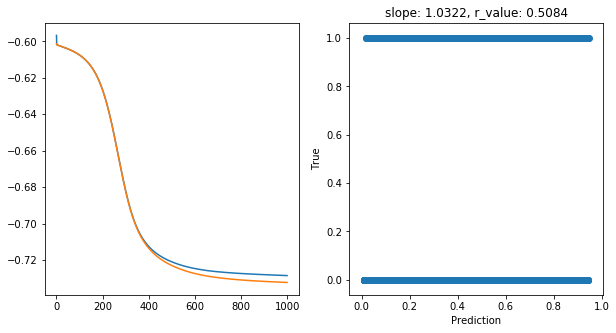
Saving model to ./models/model_SGD_1000_lr0.75_hid_dim50
hid_dim: 50, lr: 0.5
Deleting previous model
Epoch 0, train_loss: 0.2646, val_loss: 0.2505, r_value: 0.1006
Epoch 100, train_loss: 0.2486, val_loss: 0.2486, r_value: 0.3606
Epoch 200, train_loss: 0.2462, val_loss: 0.2462, r_value: 0.3978
Epoch 300, train_loss: 0.2404, val_loss: 0.2405, r_value: 0.4165
Epoch 400, train_loss: 0.2270, val_loss: 0.2273, r_value: 0.4324
Epoch 500, train_loss: 0.2092, val_loss: 0.2096, r_value: 0.4482
Epoch 600, train_loss: 0.1990, val_loss: 0.1992, r_value: 0.4651
Epoch 700, train_loss: 0.1941, val_loss: 0.1939, r_value: 0.4801
Epoch 800, train_loss: 0.1913, val_loss: 0.1906, r_value: 0.4911
Epoch 900, train_loss: 0.1895, val_loss: 0.1885, r_value: 0.4982
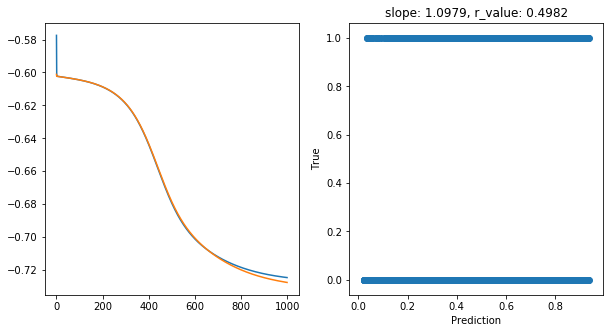
Saving model to ./models/model_SGD_1000_lr0.5_hid_dim50
hid_dim: 50, lr: 0.1
Deleting previous model
Epoch 0, train_loss: 0.2510, val_loss: 0.2507, r_value: -0.0797
Epoch 100, train_loss: 0.2498, val_loss: 0.2498, r_value: 0.1198
Epoch 200, train_loss: 0.2495, val_loss: 0.2495, r_value: 0.2430
Epoch 300, train_loss: 0.2492, val_loss: 0.2492, r_value: 0.3108
Epoch 400, train_loss: 0.2489, val_loss: 0.2489, r_value: 0.3480
Epoch 500, train_loss: 0.2485, val_loss: 0.2485, r_value: 0.3698
Epoch 600, train_loss: 0.2481, val_loss: 0.2481, r_value: 0.3834
Epoch 700, train_loss: 0.2477, val_loss: 0.2477, r_value: 0.3926
Epoch 800, train_loss: 0.2471, val_loss: 0.2472, r_value: 0.3991
Epoch 900, train_loss: 0.2465, val_loss: 0.2466, r_value: 0.4042
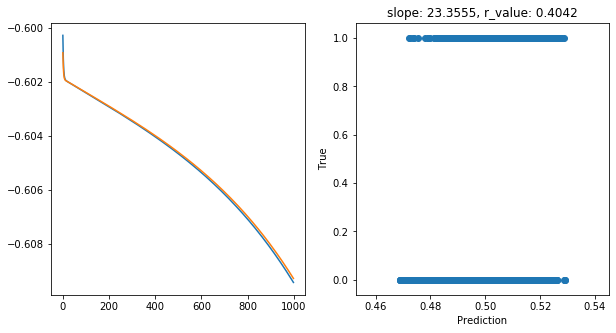
Saving model to ./models/model_SGD_1000_lr0.1_hid_dim50
hid_dim: 50, lr: 0.01
Deleting previous model
Epoch 0, train_loss: 0.2583, val_loss: 0.2578, r_value: -0.2941
Epoch 100, train_loss: 0.2507, val_loss: 0.2506, r_value: -0.2481
Epoch 200, train_loss: 0.2504, val_loss: 0.2503, r_value: -0.2167
Epoch 300, train_loss: 0.2503, val_loss: 0.2503, r_value: -0.1844
Epoch 400, train_loss: 0.2502, val_loss: 0.2502, r_value: -0.1480
Epoch 500, train_loss: 0.2502, val_loss: 0.2501, r_value: -0.1065
Epoch 600, train_loss: 0.2501, val_loss: 0.2501, r_value: -0.0603
Epoch 700, train_loss: 0.2500, val_loss: 0.2500, r_value: -0.0100
Epoch 800, train_loss: 0.2500, val_loss: 0.2500, r_value: 0.0430
Epoch 900, train_loss: 0.2499, val_loss: 0.2499, r_value: 0.0967
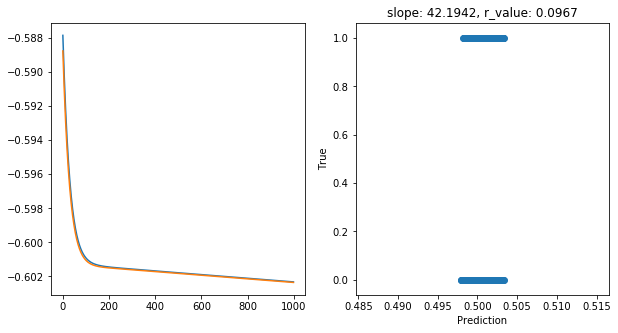
Saving model to ./models/model_SGD_1000_lr0.01_hid_dim50
hid_dim: 50, lr: 0.05
Deleting previous model
Epoch 0, train_loss: 0.2601, val_loss: 0.2584, r_value: -0.1342
Epoch 100, train_loss: 0.2499, val_loss: 0.2500, r_value: 0.1041
Epoch 200, train_loss: 0.2497, val_loss: 0.2497, r_value: 0.3417
Epoch 300, train_loss: 0.2495, val_loss: 0.2495, r_value: 0.3898
Epoch 400, train_loss: 0.2493, val_loss: 0.2493, r_value: 0.4041
Epoch 500, train_loss: 0.2491, val_loss: 0.2491, r_value: 0.4101
Epoch 600, train_loss: 0.2488, val_loss: 0.2489, r_value: 0.4132
Epoch 700, train_loss: 0.2486, val_loss: 0.2486, r_value: 0.4151
Epoch 800, train_loss: 0.2483, val_loss: 0.2484, r_value: 0.4165
Epoch 900, train_loss: 0.2481, val_loss: 0.2481, r_value: 0.4176
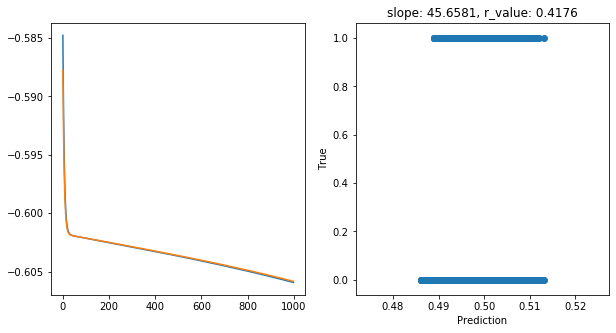
Saving model to ./models/model_SGD_1000_lr0.05_hid_dim50
hid_dim: 50, lr: 0.001
Deleting previous model
Epoch 0, train_loss: 0.2582, val_loss: 0.2579, r_value: 0.4330
Epoch 100, train_loss: 0.2559, val_loss: 0.2556, r_value: 0.4400
Epoch 200, train_loss: 0.2541, val_loss: 0.2539, r_value: 0.4456
Epoch 300, train_loss: 0.2528, val_loss: 0.2527, r_value: 0.4501
Epoch 400, train_loss: 0.2519, val_loss: 0.2518, r_value: 0.4537
Epoch 500, train_loss: 0.2513, val_loss: 0.2511, r_value: 0.4565
Epoch 600, train_loss: 0.2508, val_loss: 0.2507, r_value: 0.4588
Epoch 700, train_loss: 0.2504, val_loss: 0.2503, r_value: 0.4606
Epoch 800, train_loss: 0.2502, val_loss: 0.2501, r_value: 0.4620
Epoch 900, train_loss: 0.2500, val_loss: 0.2499, r_value: 0.4632
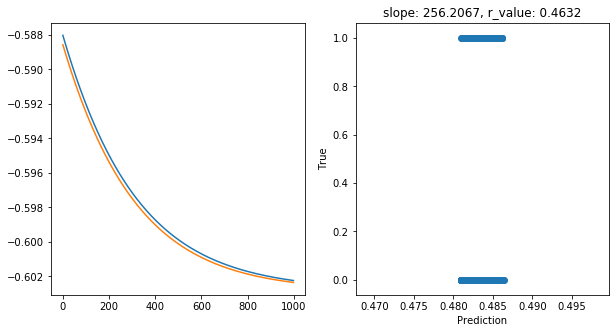
Saving model to ./models/model_SGD_1000_lr0.001_hid_dim50
hid_dim: 100, lr: 0.75
Deleting previous model
Epoch 0, train_loss: 0.2500, val_loss: 0.2502, r_value: 0.4543
Epoch 100, train_loss: 0.2573, val_loss: 0.2568, r_value: 0.4469
Epoch 200, train_loss: 0.2251, val_loss: 0.2245, r_value: 0.4513
Epoch 300, train_loss: 0.1965, val_loss: 0.1964, r_value: 0.4726
Epoch 400, train_loss: 0.1918, val_loss: 0.1912, r_value: 0.4883
Epoch 500, train_loss: 0.1897, val_loss: 0.1886, r_value: 0.4971
Epoch 600, train_loss: 0.1887, val_loss: 0.1873, r_value: 0.5017
Epoch 700, train_loss: 0.1882, val_loss: 0.1866, r_value: 0.5041
Epoch 800, train_loss: 0.1879, val_loss: 0.1862, r_value: 0.5057
Epoch 900, train_loss: 0.1876, val_loss: 0.1859, r_value: 0.5068
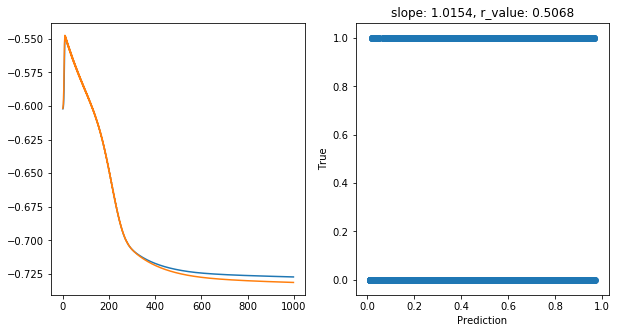
Saving model to ./models/model_SGD_1000_lr0.75_hid_dim100
hid_dim: 100, lr: 0.5
Deleting previous model
Epoch 0, train_loss: 0.2525, val_loss: 0.2511, r_value: -0.1845
Epoch 100, train_loss: 0.2471, val_loss: 0.2471, r_value: 0.4080
Epoch 200, train_loss: 0.2403, val_loss: 0.2406, r_value: 0.4059
Epoch 300, train_loss: 0.2252, val_loss: 0.2258, r_value: 0.4191
Epoch 400, train_loss: 0.2084, val_loss: 0.2092, r_value: 0.4386
Epoch 500, train_loss: 0.1995, val_loss: 0.2000, r_value: 0.4590
Epoch 600, train_loss: 0.1946, val_loss: 0.1946, r_value: 0.4767
Epoch 700, train_loss: 0.1916, val_loss: 0.1911, r_value: 0.4892
Epoch 800, train_loss: 0.1898, val_loss: 0.1888, r_value: 0.4970
Epoch 900, train_loss: 0.1887, val_loss: 0.1874, r_value: 0.5019
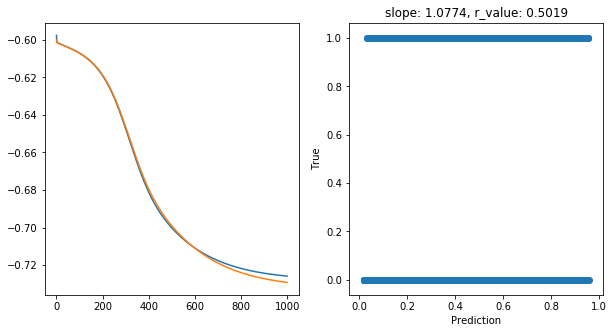
Saving model to ./models/model_SGD_1000_lr0.5_hid_dim100
hid_dim: 100, lr: 0.1
Deleting previous model
Epoch 0, train_loss: 0.2532, val_loss: 0.2514, r_value: -0.0951
Epoch 100, train_loss: 0.2494, val_loss: 0.2494, r_value: 0.3980
Epoch 200, train_loss: 0.2486, val_loss: 0.2487, r_value: 0.4343
Epoch 300, train_loss: 0.2479, val_loss: 0.2479, r_value: 0.4409
Epoch 400, train_loss: 0.2470, val_loss: 0.2470, r_value: 0.4432
Epoch 500, train_loss: 0.2459, val_loss: 0.2460, r_value: 0.4445
Epoch 600, train_loss: 0.2447, val_loss: 0.2448, r_value: 0.4456
Epoch 700, train_loss: 0.2432, val_loss: 0.2433, r_value: 0.4466
Epoch 800, train_loss: 0.2414, val_loss: 0.2415, r_value: 0.4477
Epoch 900, train_loss: 0.2392, val_loss: 0.2393, r_value: 0.4488
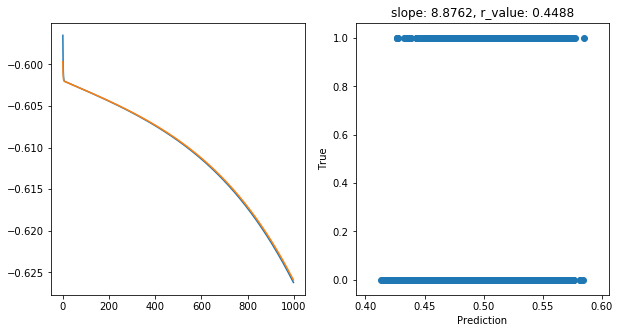
Saving model to ./models/model_SGD_1000_lr0.1_hid_dim100
hid_dim: 100, lr: 0.01
Deleting previous model
Epoch 0, train_loss: 0.2545, val_loss: 0.2540, r_value: -0.2149
Epoch 100, train_loss: 0.2503, val_loss: 0.2503, r_value: -0.1830
Epoch 200, train_loss: 0.2502, val_loss: 0.2502, r_value: -0.1324
Epoch 300, train_loss: 0.2501, val_loss: 0.2501, r_value: -0.0792
Epoch 400, train_loss: 0.2500, val_loss: 0.2500, r_value: -0.0261
Epoch 500, train_loss: 0.2499, val_loss: 0.2500, r_value: 0.0248
Epoch 600, train_loss: 0.2499, val_loss: 0.2499, r_value: 0.0720
Epoch 700, train_loss: 0.2498, val_loss: 0.2498, r_value: 0.1146
Epoch 800, train_loss: 0.2497, val_loss: 0.2497, r_value: 0.1522
Epoch 900, train_loss: 0.2496, val_loss: 0.2496, r_value: 0.1849
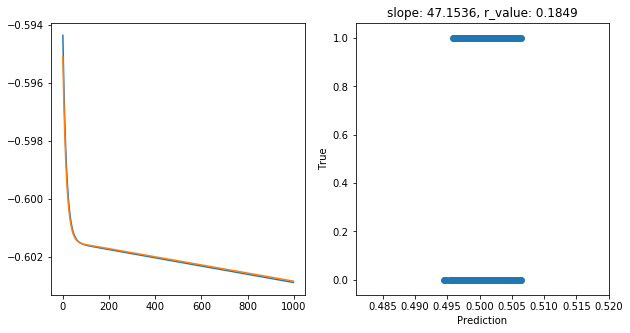
Saving model to ./models/model_SGD_1000_lr0.01_hid_dim100
hid_dim: 100, lr: 0.05
Deleting previous model
Epoch 0, train_loss: 0.2529, val_loss: 0.2521, r_value: 0.0654
Epoch 100, train_loss: 0.2495, val_loss: 0.2496, r_value: 0.1986
Epoch 200, train_loss: 0.2492, val_loss: 0.2493, r_value: 0.2893
Epoch 300, train_loss: 0.2489, val_loss: 0.2490, r_value: 0.3439
Epoch 400, train_loss: 0.2486, val_loss: 0.2486, r_value: 0.3765
Epoch 500, train_loss: 0.2482, val_loss: 0.2483, r_value: 0.3967
Epoch 600, train_loss: 0.2479, val_loss: 0.2479, r_value: 0.4098
Epoch 700, train_loss: 0.2475, val_loss: 0.2475, r_value: 0.4185
Epoch 800, train_loss: 0.2470, val_loss: 0.2471, r_value: 0.4247
Epoch 900, train_loss: 0.2466, val_loss: 0.2467, r_value: 0.4291
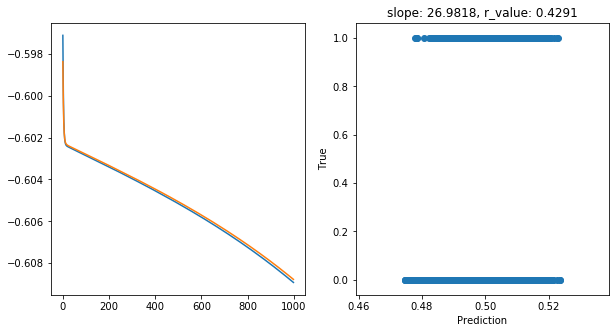
Saving model to ./models/model_SGD_1000_lr0.05_hid_dim100
hid_dim: 100, lr: 0.001
Deleting previous model
Epoch 0, train_loss: 0.2505, val_loss: 0.2504, r_value: -0.2423
Epoch 100, train_loss: 0.2503, val_loss: 0.2502, r_value: -0.2270
Epoch 200, train_loss: 0.2502, val_loss: 0.2502, r_value: -0.2116
Epoch 300, train_loss: 0.2501, val_loss: 0.2501, r_value: -0.1962
Epoch 400, train_loss: 0.2501, val_loss: 0.2501, r_value: -0.1806
Epoch 500, train_loss: 0.2501, val_loss: 0.2501, r_value: -0.1648
Epoch 600, train_loss: 0.2501, val_loss: 0.2501, r_value: -0.1485
Epoch 700, train_loss: 0.2501, val_loss: 0.2501, r_value: -0.1316
Epoch 800, train_loss: 0.2501, val_loss: 0.2501, r_value: -0.1142
Epoch 900, train_loss: 0.2501, val_loss: 0.2500, r_value: -0.0960
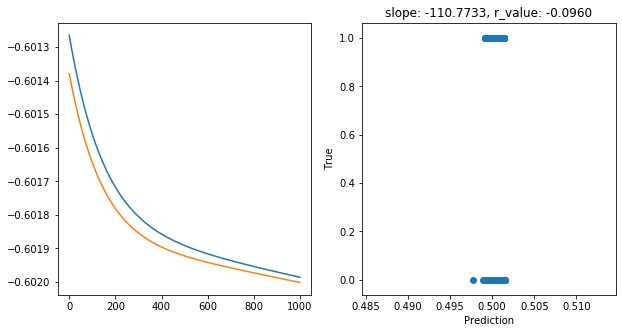
Saving model to ./models/model_SGD_1000_lr0.001_hid_dim100
2.9.5.1. ML Perceptron CONCLUSIONS
Highest r_value Performance: 0.5084 with hid_dim: 50, lr: 0.75
In general the best results are obtained with the highest Learning Rate, i.e. 0.75
Maybe increasing the number of Epochs can be benefitial?
2.9.6. GENERAL CONCLUSIONS
The modeling results are not good BUT !
It is highly dependent on the input data.
The quality of the input data for this experiment are not too much.
At least I have learned A LOT about: * How to manage spatial data using Python commands such as PyGeo and Rasterio. * How to generate statistical models * which are the key parameter to be considered during the generation of the model * How to translate these models into the final maps